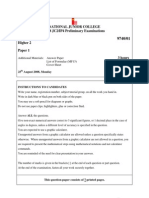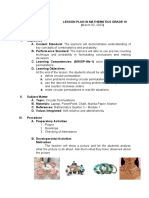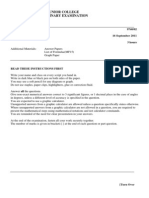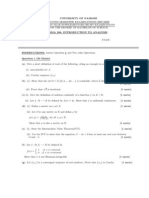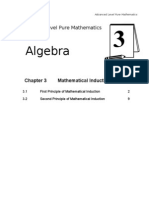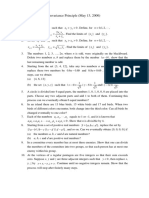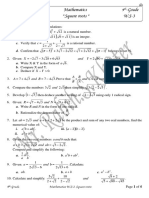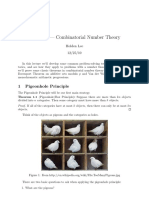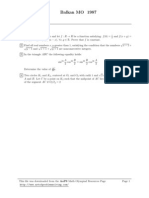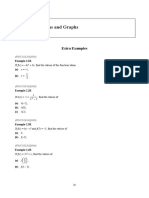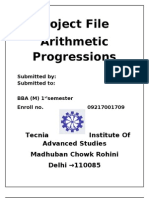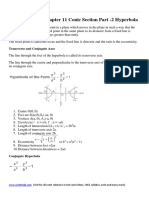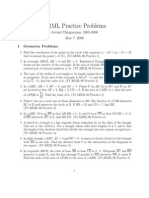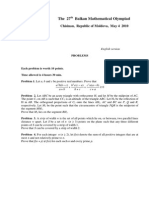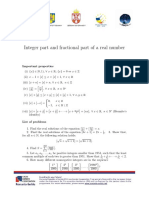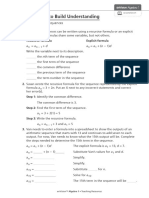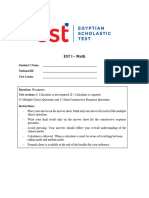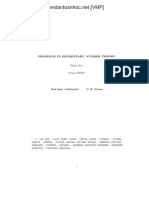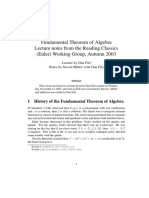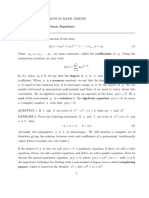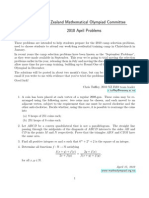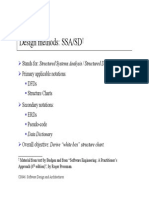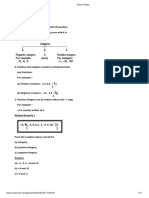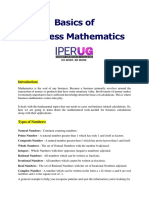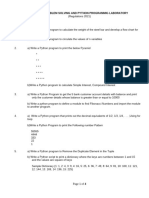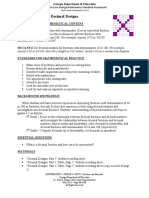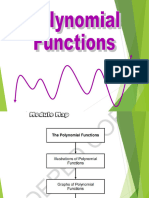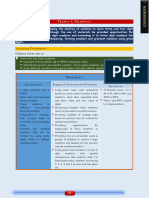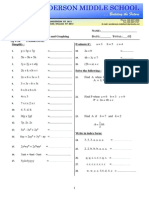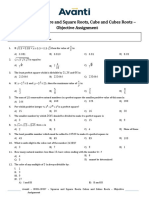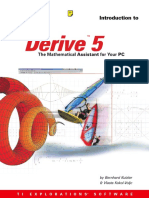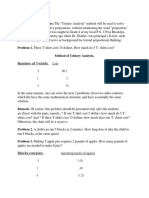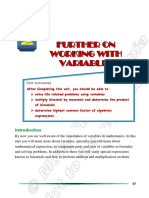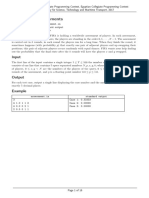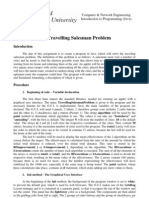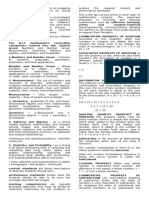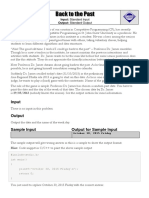Hojoo Lee Pen
Hojoo Lee Pen
Uploaded by
tranhason1705Copyright:
Available Formats
Hojoo Lee Pen
Hojoo Lee Pen
Uploaded by
tranhason1705Original Description:
Copyright
Available Formats
Share this document
Did you find this document useful?
Is this content inappropriate?
Copyright:
Available Formats
Hojoo Lee Pen
Hojoo Lee Pen
Uploaded by
tranhason1705Copyright:
Available Formats
PROBLEMS IN ELEMENTARY NUMBER THEORY
Hojoo Lee, Version 040526
God does arithmetic.
C. F. Gauss
1, 24, 252, 1472, 4830, 6048, 16744, 84480, 113643, 115920,
534612, 370944, 577738, 401856, 1217160, 987136, 6905934, 2727432,
10661420, 7109760, 4219488, 12830688, 18643272, 21288960, 25499225,
13865712, 73279080, 24647168,
PROBLEMS IN ELEMENTARY NUMBER THEORY
Contents
1.
2.
3.
4.
5.
6.
7.
8.
9.
10.
11.
12.
13.
14.
15.
16.
17.
18.
Introduction
Notations and Abbreviations
Divisibility Theory I
Divisibility Theory II
Arithmetic in Zn
Primitive Roots
Quadratic Residues
Congruences
Primes and Composite Numbers
Composite Numbers
Prime Numbers
Rational and Irrational Numbers
Rational Numbers
Irrational Numbers
Diophantine Equations I
Diophantine Equations II
Functions in Number Theory
Floor Function and Fractional Part Function
Euler phi Function
Divisor Functions
More Functions
Functional Equations
Polynomials
Sequences of Integers
Linear Recurrnces
Recursive Sequences
More Sequences
Combinatorial Number Theory
Additive Number Theory
The Geometry of Numbers
Miscellaneous Problems
Sources
References
3
4
5
12
17
17
18
18
21
21
21
25
25
26
30
35
38
38
40
40
41
42
45
47
47
48
52
55
61
66
67
71
94
PROBLEMS IN ELEMENTARY NUMBER THEORY
1. Introduction
The heart of Mathematics is its problems.
Paul Halmos
1. Introduction Number Theory is a beautiful branch of Mathematics.
The purpose of this book is to present a collection of interesting questions
in Number Theory. Many of the problems are mathematical competition
problems all over the world including IMO, APMO, APMC, Putnam, etc.
I have given sources of the problems at the end of the book. The book is
available at
http://my.netian.com/ideahitme/eng.html
2. How You Can Help This is an unfinished manuscript. I would
greatly appreciate hearing about any errors in the book, even minor ones. I
also would like to hear about
a) Challenging problems in Elementary Number Theory,
b) Interesting problems concerned with the History of Number Theory,
c) Beautiful results that are easily stated, and
d) Remarks on the problems in the book.
You can send all comments to the author at hojoolee@korea.com .
3. Acknowledgments The author is very grateful to Orlando Doehring,
who provided old IMO short-listed problems. The author also wish to thank
Arne Smeets, Ha Duy Hung, Tom Verhoeff and Tran Nam Dung for their
nice problems proposals.
PROBLEMS IN ELEMENTARY NUMBER THEORY
2. Notations and Abbreviations
Notations
Z is the set of integers
N is the set of positive integers
N0 is the set of nonnegative integers
Q is the set of rational numbers
m|n
n is a multiple
of m.
P
P
f
(d)
=
d|n
dD(n) f (d) (D(n) = {d N : d|n})
[x] the greatest integer less than or equal to x
{x} the fractional part of x ({x} = x [x])
(x) the number of primes p with p x
(n) the number of positive integers less than n that are
relatively prime to n
(n) the sum of positive divisors of n
d(n) the number of positive divisors of n
Ramanujans tau function
Abbreviations
AIME American Invitational Mathematics Examination
APMO Asian Pacific Mathemats Olympiads
IMO International Mathematical Olympiads
CRUX Crux Mathematicorum (with Mathematical Mayhem)
PROBLEMS IN ELEMENTARY NUMBER THEORY
3. Divisibility Theory I
Why are numbers beautiful? Its like asking why is Beethovens Ninth
Symphony beautiful. If you dont see why, someone cant tell you. I know
numbers are beautiful. If they arent beautiful, nothing is. Paul Erdos
A 1. (Kiran S. Kedlaya) Show that if x, y, z are positive integers, then
(xy + 1)(yz + 1)(zx + 1) is a perfect square if and only if xy + 1, yz + 1,
zx + 1 are all perfect squares.
A 2. Find infinitely many triples (a, b, c) of positive integers such that a, b,
c are in arithmetic progression and such that ab + 1, bc + 1, and ca + 1 are
perfect squares.
A 3. Let a and b be positive integers such that ab + 1 divides a2 + b2 . Show
that
a2 + b2
ab + 1
is the square of an integer.
A 4. (Shailesh Shirali) If a, b, c are positive integers such that
0 < a2 + b2 abc c,
show that a2 + b2 abc is a perfect square.
A 5. Let x and y be positive integers such that xy divides x2 + y 2 + 1. Show
that
x2 + y 2 + 1
= 3.
xy
A 6. (R. K. Guy and R. J. Nowakowki) (i) Find infinitely many pairs of
integers a, b with 1 < a < b, so that ab exactly divides a2 + b2 1. (ii) With
a and b as in (i), what are the possible values of
a2 + b2 1
.
ab
A 7. Let n be
a positive integer such that 2 + 2 28n2 + 1 is an integer.
Show that 2 + 2 28n2 + 1 is the square of an integer.
A 8. The integers a and b have the property that for every nonnegative
integer n the number of 2n a + b is the square of an integer. Show that a = 0.
A 9. Prove that among any ten consecutive positive integers at least one is
relatively prime to the product of the others.
1This is a generalization of A3 ! Indeed, a2 + b2 abc = c implies that
a2 +b2
ab+1
= c N.
PROBLEMS IN ELEMENTARY NUMBER THEORY
A 10. Let n be a positive integer with n 3. Show that
nn
nn
nn
is divisible by 1989.
A 11. Let a, b, c, d be integers. Show that the product
(a b)(a c)(a d)(b c)(b d)(c d)
is divisible by 12.
A 12. If a1 < a2 < < an are integers, show that
Y ai aj
ij
1i<jn
is an integer.
A 13. Let k, m, n be natural numbers such that m + k + 1 is a prime greater
than n + 1. Let cs = s(s + 1). Prove that the product (cm+1 ck )(cm+2
ck ) (cm+n ck ) is divisible by the product c1 c2 cn .
A 14. Show that for all prime numbers p
Q(p) =
p1
Y
k 2kp1
k=1
is an integer.
A 15. Let n be an integer with n 2. Show that n does not divide 2n 1.
A 16. Suppose that k 2 and n1 , n2 , , nk 1 be natural numbers having
the property
n2 | 2n1 1, n3 | 2n2 1, , nk | 2nk1 1, n1 | 2nk 1.
Show that n1 = n2 = = nk = 1.
A 17. Determine if there exists a positive integer n such that n has exactly
2000 prime divisors and 2n + 1 is divisible by n.
A 18. Let m and n be natural numbers such that
(m + 3)n + 1
A=
.
3m
is an integer. Prove that A is odd.
A 19. Let m and n be natural numbers and let mn + 1 be divisible by 24.
Show that m + n is divisible by 24, too.
A 20. Let f (x) = x3 + 17. Prove that for each natural number n 2, there
is a natural number x for which f (x) is divisible by 3n but not 3n+1 .
2The result follows immediately from the theory of Lie groups; the number turns out
to be the dimension of an irreducible representation of SU (n). [Rc]
PROBLEMS IN ELEMENTARY NUMBER THEORY
A 21. Determine all positive integers n for which there exists an integer m
so that 2n 1 divides m2 + 9.
A 22. Let n be a positive integer. Show that the product of n consecutive
integers is divisible by n!
A 23. Prove that the number
n
X
2n + 1 3k
2
2k + 1
k=0
is not divisible by 5 for any integer n 0.
A 24. (Wolstenholmes Theorem) Prove that if
1
1 1
1 + + + +
2 3
p1
is expressed as a fraction, where p 5 is a prime, then p2 divides the
numerator.
A 25. If p is a prime number greater than 3 and k = [ 2p
3 ]. Prove that
p
p
p
+
+ +
1
2
k
is divisible by p2 .
A 26. Show that
2n
n
| lcm[1, 2, , 2n] for all positive integers n.
A 27. Let m and n be arbitrary non-negative integers. Prove that
(2m)!(2n)!
m!n!(m + n)!
is an integer. (0! = 1).
A 28. Show that the coefficients of a binomial expansion (a + b)n where n
is a positive integer, are odd, if and only if n is of the form 2k 1 for some
positive integer k.
A 29. Prove that the expression
gcd(m, n) n
n
m
is an integer for all pairs of positive integers n m 1.
A 30. For which positive integers k, is it true that there are infinitely many
pairs of positive integers (m, n) such that
(m + n k)!
m! n!
is an integer ?
A 31. Show that if n 6 is composite, then n divides (n 1)!.
PROBLEMS IN ELEMENTARY NUMBER THEORY
A 32. Show that there exist infinitely many positive integers n such that
n2 + 1 divides n!.
A 33. Let p and q be natural numbers such that
p
1 1 1
1
1
= 1 + +
+
.
q
2 3 4
1318 1319
Prove that p is divisible by 1979.
A 34. Let b > 1, a and n be positive integers such that bn 1 divides a.
Show that in base b, the number a has at least n non-zero digits.
A 35. Let p1 , p2 , , pn be distinct primes greater than 3. Show that
2p1 p2 pn + 1
has at least 4n divisors.
A 36. Let p 5 be a prime number. Prove that there exists an integer a
with 1 a p 2 such that neither ap1 1 nor (a + 1)p1 1 is divisible
by p2 .
A 37. An integer n > 1 and a prime p are such that n divides p 1, and p
divides n3 1. Show that 4p + 3 is the square of an integer.
A 38. Let
h n and
i q be integers with n 5, 2 q n. Prove that q 1
(n1)!
divides
.
q
A 39. If n is a natural number, prove that the number (n + 1)(n + 2) (n +
10) is not a perfect square.
A 40. Let p be a prime with p > 5, and let S = {p n2 |n N, n2 < p}.
Prove that S contains two elements a, b such that a|b and 1 < a < b.
A 41. Let n be a positive integer. Prove that the following two statements
are equivalent.
n is not divisible by 4
There exist a, b Z such that a2 + b2 + 1 is divisible by n.
A 42. Determine the greatest common divisor of the elements of the set
{n13 n|n Z}.
A 43. Show that there are infinitely many composite n such that 3n1 2n1
is divisible by n
A 44. Suppose that 2n +1 is an odd prime for some positive integer n. Show
that n must be a power of 2.
A 45. Suppose that p is a prime number and is greater than 3. Prove that
7p 6p 1 is divisible by 43.
A 46. Suppose that 4n + 2n + 1 is prime for some positive integer n. Show
that n must be a power of 3.
PROBLEMS IN ELEMENTARY NUMBER THEORY
A 47. Let b, m, n be positive integers b > 1 and m and n are different.
Suppose that bm 1 and bn 1 have the same prime divisors. Show that
b + 1 must be a power of 2.
A 48. Let a and b be integers. Show that a and b have the same parity if
and only if there exist integers c and d such that a2 + b2 + c2 + 1 = d2 .
A 49. Let n be a positive integer with n > 1. Prove that
1
1
+ +
2
n
is not an integer.
A 50. Let n be a positive integer. Prove that
1
1
+ +
3
2n + 1
is not an integer.
A 51. Prove that there is no positive integer n such that, for k = 1, 2, , 9,
the leftmost digit (in decimal notation) of (n + k)! equals k.
A 52. Show that every integer k > 1 has a multiple less than k 4 whose
decimal expansion has at most four distinct digits.
A 53. Let a, b, c and d be odd integers such that 0 < a < b < c < d and
ad = bc. Prove that if a + d = 2k and b + c = 2m for some integers k and
m, then a = 1.
A 54. Let d be any positive integer not equal to 2, 5, or 13. Show that one
can find distinct a, b in the set {2, 5, 13, d} such that ab 1 is not a perfect
square.
A 55. Suppose that x, y, z are positive integers with xy = z 2 + 1. Prove that
there exist integers a, b, c, d such that x = a2 + b2 , y = c2 + d2 , z = ac + bd.
A 56. A natural number n is said to have the property P , if whenever n
divides an 1 for some integer a, n2 also necessarily divides an 1.
(a) Show that every prime number n has propery P .
(b) Show that there are infinitely many composite numbers n
that possess property P .
A 57. Show that for every natural number n the product
2
2
2
2
4
4
4
4
1
2
3
n
is an integer.
A 58. Let a, b, c be integers such that a + b + c divides a2 + b2 + c2 . Prove
that there are infinitely many positive integers n such that a + b + c divides
an + bn + cn .
10
PROBLEMS IN ELEMENTARY NUMBER THEORY
A 59. Prove that for every n N the following proposition holds : The
number 7 is a divisor of 3n + n3 if and only if 7 is a divisor of 3n n3 + 1.
A 60. Let k 14 be an integer, and let pk be the largest prime number
which is strictly less than k. You may assume that pk 3k/4. Let n be a
composite integer. Prove :
(a) if n = 2pk , then n does not divide (n k)!
(b) if n > 2pk , then n divides (n k)!.
A 61. Suppose that n has (at least) two essentially distinct representations
as a sum of two squares. Specifically, let n = s2 + t2 = u2 + v 2 , where
s t 0, u v 0, and s > u. Show that gcd(su tv, n) is a proper
divisor of n.
A 62. Prove that there exist an infinite number of ordered pairs (a, b) of
integers such that for every positive integer t, the number at+b is a triangular
number if and only if t is a triangular number3.
A 63. For any positive integer n > 1, let p(n) be the greatest prime divisor
of n. Prove that there are infinitely many positive integers n with
p(n) < p(n + 1) < p(n + 2).
A 64. Let p(n) be the greatest odd divisor of n. Prove that
n
2
1 X p(k)
2
> .
n
2
k
3
k=1
A 65. There is a large pile of cards. On each card one of the numbers 1, 2,
, n is written. It is known that the sum of all numbers of all the cards is
equal to k n! for some integer k. Prove that it is possible to arrange cards
into k stacks so that the sum of numbers written on the cards in each stack
is equal to n!.
A 66. The last digit of the number x2 + xy + y 2 is zero (where x and y are
positive integers). Prove that two last digits of this numbers are zeros.
A 67. Clara computed the product of the first n positive integers and Valerid
computed the product of the first m even positive integers, where m 2.
They got the same answer. Prove that one of them had made a mistake.
A 68. (Four Number Theorem) Let a, b, c, and d be positive integers such
that ab = cd. Show that there exists positive integers p, q, r, and s such that
a = pq, b = rs, c = pt, and d = su.
2n
A 69. Prove that n is divisible by n + 1.
A 70. Suppose that a1 , , ar are positive integers. Show that lcm[a1 , , ar ] =
r+1
a1 ar (a1 , a2 )1 (ar1 , ar )1 (a1 , a2 , a3 )(a1 , a2 , a3 ) (a1 , a2 , ar )(1) .
3The triangular numbers are the t = n(n + 1)/2 with n {0, 1, 2, . . . }.
n
PROBLEMS IN ELEMENTARY NUMBER THEORY
11
A 71. Prove that if the odd prime p divides ab 1, where a and b are positive
integers, then p appears to the same power in the prime factorization of
b(ad 1), where d is the greatest common divisor of b and p 1.
A 72. Suppose that m = nq, where n and q are positive integers. Prove that
the sum of binomial coefficients
n1
X (n, k)q
(n, k)
k=0
is divisible by m, where (x, y) denotes the greatest common divisor of x and
y.
12
PROBLEMS IN ELEMENTARY NUMBER THEORY
4. Divisibility Theory II
Number theorists are like lotus-eaters - having tasted this food they can
never give it up. Leopold Kronecker
B 1. Determine all integers n > 1 such that
2n + 1
n2
is an integer.
B 2. Determine all pairs (n, p) of nonnegative integers such that
p is a prime,
n < 2p, and
(p 1)n + 1 is divisible by np1 .
B 3. Determine all pairs (n, p) of positive integers such that
p is a prime, n > 1,
(p 1)n + 1 is divisible by np1 . 4
B 4. Find an integer n, where 100 n 1997, such that
2n + 2
n
is also an integer.
B 5. Find all triples (a, b, c) such that 2c 1 divides 2a + 2b + 1.
B 6. Find all integers a, b, c with 1 < a < b < c such that
(a 1)(b 1)(c 1)
is a divisor of
abc 1.
B 7. Find all positive integers, representable uniquely as
x2 + y
,
xy + 1
where x and y are positive integers.
B 8. Determine all ordered pairs (m, n) of positive integers such that
n3 + 1
mn 1
is an integer.
B 9. Determine all pairs of integers (a, b) such that
a2
2a2 b b3 + 1
is a positive integer.
4The answer is (n, p) = (2, 2), (3, 3). Note that this problem is a very nice generalization
of the above two IMO problems B1 and B2 !
PROBLEMS IN ELEMENTARY NUMBER THEORY
13
B 10. Find all pairs of positive integers m, n 3 for which there exist
infinitely many positive integers a such that
am + a 1
an + a2 1
is itself an integer.
B 11. Determine all triples of positive integers (a, m, n) such that am + 1
divides (a + 1)n .
B 12. Which integers are represented by
positive integers?
B 13. Find all n N such that [ n] | n.
(x+y+z)2
xyz
where x, y, and z are
B 14. Determine
all n N for which (i) n is not the square of any integer,
and (ii) [ n]3 divides n2 .
B 15. Find all n N such that 2n1 | n!.
B 16. Find all positive integers (x, n) such that xn + 2n + 1 is a divisor of
xn+1 + 2n+1 + 1.
B 17. Find all positive integers n such that 3n 1 is divisible by 2n .
B 18. Find all positive integers n such that 9n 1 is divisible by 7n .
B 19. Determine all pairs (a, b) of integers for which a2 + b2 + 3 is divisible
by ab.
B 20. Determine all pairs (x, y) of positive integers with y|x2 +1 and x|y 3 +1.
B 21. Determine all pairs (a, b) of positive integers such that ab2 + b + 7
divides a2 b + a + b.
B 22. Let a and b be positive integers. When a2 + b2 is divided by a + b,
the quotient is q and the remainder is r. Find all pairs (a, b) such that
q 2 + r = 1977.
B 23. Find the largest positive integer n such that n is divisible by all the
positive integers less than n1/3 .
B 24. Find all n N such that 3n n is divisible by 17.
B 25. Suppose that a, b are natural numbers such that
r
4 2a b
p=
b 2a + b
is a prime number. What is the maximum possible value of p?
B 26. Find all positive integer N which have the following properties
N has exactly 16 positive divisors 1 = d1 < d2 < <
d15 < d16 = N ,
The divisor with d2 is equal to (d2 + d4 )d6 .
14
PROBLEMS IN ELEMENTARY NUMBER THEORY
B 27. Find all positive integers n that have exactly 16 positive integral
divisors d1 , d2 , d16 such that 1 = d1 < d2 < < d16 = n, d6 = 18, and
d9 d8 = 17.
B 28. Suppose that n is a positive integer and let
d1 < d2 < d3 < d4
be the four smallest positive integer divisors of n. Find all integers n such
that
n = d1 2 + d2 2 + d3 2 + d4 2 .
B 29. Let 1 = d1 < d2 < < dk = n be all different divisors of positive
integer n written in ascending order. Determine all n such that
n 2
2
2
d7 + d10 =
.
d22
B 30. Let n 2 be a positive integer, with divisors
1 = d1 < d 2 < < d k = n .
Prove that
is always less than
n2 ,
d1 d2 + d2 d3 + + dk1 dk
and determine when it is a divisor of n2 .
B 31. Find all positive integers n such that (a) n has exactly 6 positive
divisors 1 < d1 < d2 < d3 < d4 < n, and (b) 1 + n = 5(d1 + d2 + d3 + d4 ).
B 32. Find all composite numbers n, having the property : each divisor d
of n (d =
6 1, n) satisfies inequalities n 20 d n 12.
B 33. Determine all three-digit numbers N having the property that N is
N
divisible by 11, and 11
is equal to the sum of the squares of the digits of N.
B 34. When 44444444 is written in decimal notation, the sum of its digits
is A. Let B be the sum of the digits of A. Find the sum of the digits of B.
(A and B are written in decimal notation.)
B 35. A wobbly number is a positive integer whose digits in base 10 are
alternatively non-zero and zero the units digit being non-zero. Determine
all positive integers which do not divide any wobbly number.
B 36. Let n be a composite natural number and p be a proper divisor of n.
Find the binary representation of the smallest natural number N such that
(1 + 2p + 2np )N 1
2
is an integer.
B 37. Find the smallest positive integer n such that
(i) n has exactly 144 distinct positive divisors, and
(ii) there are ten consecutive integers among the positive divisors of n.
PROBLEMS IN ELEMENTARY NUMBER THEORY
15
B 38. Determine the least possible value of the natural number n such that
n! ends in exactly 1987 zeros.
B 39. Find four positive integers, each not exceeding 70000 and each having
more than 100 divisors.
B 40. For each integer n > 1, let p(n) denote the largest prime factor of n.
Determine all triples (x, y, z) of distinct positive integers satisfying
(i) x, y, z are in arithmetic progression, and
(ii) p(xyz) 3.
B 41. Find all positive integers a and b such that
a2 + b
b2 a
and
b2 + a
a2 b
are both integers.
P
B 42. For each positive integer n, write the sum nm=1 1/m in the form
pn /qn , where pn and qn are relatively prime positive integers. Determine all
n such that 5 does not divide qn .
B 43. Find all natural numbers n such that the number n(n+1)(n+2)(n+3)
has exactly three prime divisors.
B 44. Prove that there exist infinitely many pairs (a, b) of relatively prime
positive integers such that
a2 5
b2 5
and
b
a
are both positive integers.
B 45. Determine all triples (l, m, n) of distinct positive integers satisfying
gcd(l, m)2 = l + m, gcd(m, n)2 = m + n, and gcd(n, l)2 = n + l.
B 46. What is the greatest common divisor of the set of numbers
{16n + 10n 1 | n = 1, 2, }?
B 47. (I. Selishev) Does there exist a 4-digit integer (in decimal form) such
that no replacement of three its digits by another three gives a multiple of
1992 ?
B 48. What is the smallest positive integer that consists of the ten digits 0
through 9, each used just once, and is divisible by each of the digits 2 through
9?
B 49. Find the smallest positive integer n which makes
21989 | mn 1
no matter what odd positive integer greater than 1 might be subustuted for
m.
16
PROBLEMS IN ELEMENTARY NUMBER THEORY
B 50. Given
k, find the number of odd binomial
the nonnegative integer
k.
coefficients m
with
0
m
<
2
r
B 51. Determine the highest power of 1980 which divides
(1980n)!
.
(n!)1980
PROBLEMS IN ELEMENTARY NUMBER THEORY
17
5. Arithmetic in Zn
Mathematics is the queen of the sciences and number theory is the queen
of Mathematics. Johann Carl Friedrich Gauss
5.1. Primitive Roots.
C 1. Let n be a positive integer. Show that there are infinitely many primes
p such that the smallest positive primitive root of p is greater than n.
2
p1
C 2. Let p be a prime with p > 4 (p1)
22k , where k denotes the number
of distinct prime divisors of p 1, and let Mh be an integer.
Prove that
i
p1
k
the set of integers M + 1, M + 2, , M + 2 (p1) 2 p 1 contains a
primitive root to modulus p.
C 3. Show that for each odd prime p, there is an integer g such that 1 <
g < p and g is a primitive root modulo pn for every positive integer n.
C 4. Let g be a Fibonacci primitive root (mod p). i.e. g is a primitive root
(mod p) satisfying g 2 g + 1(mod p). Prove that
(a) g 1 is also a primitive root (mod p).
(b) if p = 4k + 3, then (g 1)2k+3 g 2(mod p) and deduce
that g 2 is also a primitive root (mod p).
C 5. Let p be an odd prime. If g1 , , g(p1) are the primitive roots mod
p in the range 1 < g p 1, prove that
(p1)
gi (p 1)(mod p).
i=1
C 6. Suppose that m does not have a primitive root. Show that
a
(m)
2
1 (mod m)
for every a relatively prime m.
C 7. Suppose that p > 3 is prime. Prove that the products of the primitive
roots of p between 1 and p 1 is congruent to 1 modulo p.
C 8. Let p be a prime. Let g be a primitive root of modulo p. Prove that
there is no k such that g k+2 = g k+1 + 1 = g k + 2 (mod p).
18
PROBLEMS IN ELEMENTARY NUMBER THEORY
5.2. Quadratic Residues.
C 9. Find all positive integers n that are quadratic residues modulo all
primes greater than n.
C 10. The positive integers a and b are such that the numbers 15a + 16b
and 16a 15b are both squares of positive integers. What is the least possible
value that can be taken on by the smaller of these two squares?
C 11. Let p be an odd prime number. Show that the smallest positive qua
dratic nonresidue of p is smaller than p + 1.
C 12. Let M be an integer, and let p be a prime with p > 25. Show that the
sequence M , M + 1, , M + 3[ p] 1 contains a quadratic non-residue to
modulus p.
C 13. Let p be an odd prime and let Zp denote (the field of ) integers modulo
p. How many elements are in the set
{x2 : x Zp } {y 2 + 1 : y Zp }?
C 14. Let a, b, c be integers and let p be an odd prime with
p 6 |a and p 6 |b2 4ac.
Show that
p
X
ak 2 + bk + c
p
k=1
a
=
.
p
5.3. Congruences.
C 15. If p is an odd prime, prove that
k
k
(mod p).
p
p
C 16. Suppose p is an odd prime. Prove that
p
X
p p+j
2p + 1 (mod p2 ).
j
j
j=0
C 17. (Morley) Show that
(1)
p1
2
p1
p1
2
4p1 (mod p3 )
for all prime numbers p with p 5.
C 18. Let n be a positive integer. Prove that n is prime if and only if
n1
(1)k (mod n)
k
for all k {0, 1, , n 1}.
PROBLEMS IN ELEMENTARY NUMBER THEORY
19
C 19. Prove that for n 2,
n terms
z}|{
2
22
n 1 terms
z}|{
2
22
(mod n).
C 20. Show that, for any fixed integer n 1, the sequence
2
22
2, 22 , 22 , 22 , (mod n)
is eventually constant.
C 21. Somebody incorrectly remembered Fermats little theorem as saying
that the congruence an+1 a (mod n) holds for all a if n is prime. Describe
the set of integers n for which this property is in fact true.
C 22. Characterize the set of positive integers n such that, for all integers
a, the sequence a, a2 , a3 , is periodic modulo n.
C 23. Show that there exists a composite number n such that an a (mod n)
for all a Z.
C 24. Let p be a prime number of the form 4k + 1. Suppose that 2p + 1 is
prime. Show that there is no k N with k < 2p and 2k 1 (mod 2p + 1)
C 25. During a break, n children at school sit in a circle around their teacher
to play a game. The teacher walks clockwise close to the children and hands
out candies to some of them according to the following rule. He selects one
child and gives him a candy, then he skips the next child and gives a candy
to the next one, then he skips 2 and gives a candy to the next one, then he
skips 3, and so on. Determine the values of n for which eventually, perhaps
after many rounds, all children will have at least one candy each.
C 26. Suppose that m > 2, and let P be the product of the positive integers
less than m that are relatively prime to m. Show that P 1(mod m) if
m = 4, pn , or 2pn , where p is an odd prime, and P 1(mod m) otherwise.
C 27. Let consist of all polynomials in x with integer coefficients. For f
and g in and m a positive integer, let f g (mod m) mean that every
coefficient of f g is an integral multiple of m. Let n and p be positive
integers with p prime. Given that f, g, h, r and s are in with rf + sg 1
(mod p) and f g h (mod p), prove that there exist F and G in with
F f (mod p), G g (mod p), and F G h (mod pn ).
C 28. Determine the number of integers n 2 for which the congruence
x25 x (mod n)
is true for all integers x.
C 29. Let n1 , , nk and a be positive integers which satify the following
conditions :
20
PROBLEMS IN ELEMENTARY NUMBER THEORY
i) for any i 6= j, (ni , nj ) = 1,
ii) for any i, ani 1(mod ni ),
iii) for any i, ni 6 |a 1.
Show that there exist at least 2k+1 2 integers x > 1 with ax 1(mod x).
C 30. Determine all positive integers n 2 that satisfy the following condition ; For all integers a, b relatively prime to n,
a b (mod n) ab 1 (mod n).
C 31. Determine all positive integers n such that xy+1 0 (mod n) implies
that x + y 0 (mod n).
C 32. Let p be a prime number. Determine the maximal degree of a polynomial T (x) whose coefficients belong to {0, 1, , p 1} whose degree is less
than p, and which satisfies
T (n) = T (m) (mod p) = n = m (mod p)
for all integers n, m.
C 33. Let a1 , , ak and m1 , , mk be integers 2 m1 and 2mi mi+1
for 1 i k 1. Show that there are infinitely many integers x which do
not satisfy any of congruences
x a1 (mod m1 ), x a2 (mod m2 ), , x ak (mod mk ).
C 34. Show that 1994 divides 10900 21000 .
C 35. Determine the last three digits of
2001
20032002
19811982
C 36. Prove that 1980
19811980
+ 1982
is divisible by 19811981 .
C 37. Every odd prime is of the form p = 4n + 1.
(a) Show that n is a quadratic residue (mod p).
(b) Calculate the value nn (mod p).
PROBLEMS IN ELEMENTARY NUMBER THEORY
21
6. Primes and Composite Numbers
Wherever there is number, there is beauty. Proclus Diadochus
6.1. Composite Numbers.
D 1. Prove that the number 5123 + 6753 + 7203 is composite.
D 2. Let a, b, c, d be integers with a > b > c > d > 0. Suppose that
ac + bd = (b + d + a c)(b + d a + c). Prove that ab + cd is not prime.
D 3. Find the sum of all distinct positive divisors of the number 104060401.
D 4. Prove that 1280000401 is composite.
D 5. Prove that
5125 1
525 1
is a composite number.
D 6. Find the factor of 233 219 217 1 that lies between 1000 and 5000.
D 7. Show that there exists a positive integer k such that k 2n + 1 is
composite for all n N0 .
D 8. Show that for all integer k > 1, there are infinite many natural numbers
n
n such that k 22 + 1 is composite.
D 9. Four integers are marked on a circle. On each step we simultaneously
replace each number by the difference between this number and next number
on the circle in a given direction (that is, the numbers a, b, c, d are replaced
by a b, b c, c d, d a). Is it possible after 1996 such steps to have
numbers a, b, c, d such that the numbers |bc ad|, |ac bd|, |ab cd| are
primes ?
D 10. Represent the number 989 1001 1007 + 320 as the product of primes.
D 11. In 1772 Euler discovered the curious fact that n2 + n + 41 is prime
when n is any of 0, 1, 2, , 39. Show that there exist 40 consecutive integer
values of n for which this polynomial is not prime.
6.2. Prime Numbers.
D 12. Show that there are infinitely many primes.
D 13. Find all natural numbers n for which every natural number whose
decimal representation has n 1 digits 1 and one digit 7 is prime.
D 14. Prove that there do not exist polynomials P and Q such that
P (x)
(x) =
Q(x)
for all x N.
D 15. Show that there exist two consecutive integer squares such that there
are at least 1000 primes between them.
22
PROBLEMS IN ELEMENTARY NUMBER THEORY
D 16. Prove that for any prime p in the interval n, 4n
3 , p divides
n 4
X
n
j
j=0
D 17. Let a, b, and n be positive integers with gcd(a, b) = 1. Without using
the Dirichlets theorem5, show that there are infinitely many k N such
that gcd(ak + b, n) = 1.
D 18. Without using the Dirichlets theorem, show that there are infinitely
many primes ending in the digit 9.
D 19. Let p be an odd prime. Without using the Dirichlets theorem, show
that there are infinitely many primes of the form 2pk + 1.
D 20. Verify that, for each r 1, there are infinitely many primes p
1 (mod 2r ).
D 21. Prove that if p is a prime, then pp 1 has a prime factor that is
congruent to 1 modulo p.
D 22. Let p be a prime number. Prove that there exists a prime number q
such that for every integer n, np p is not divisible by q.
D 23. Let p1 = 2, p2 = 3, p3 = 5, , pn be the first n prime numbers, where
n 3. Prove that
1
1
1
1
1
< .
+ 2 + + 2 +
2
p1
p2
pn
p1 p2 pn
2
D 24. Let pn be the nth prime : p1 = 2, p2 = 3, p3 = 5, . Show that the
infinite series
X
1
n=1
pn
diverges.
D 25. Prove that log n k log 2, where n is a natural number and k is the
number of distinct primes that divide n.
D 26. Find the smallest prime which is not the difference (in some order)
of a power of 2 and a power of 3.
D 27. Prove that for each positive integer n there exist n consecutive positive
integers none of which is an integral power of a prime number.
D 28. Show that n(2n)(n) < 4n for all positive integer n.
D 29. Let sn denote the sum of the first n primes. Prove that for each n
there exists an integer whose square lies between sn and sn+1 .
5For any a, b N with gcd(a, b) = 1, there are infinitely many primes of the form
ak + b.
PROBLEMS IN ELEMENTARY NUMBER THEORY
23
D 30. Given an odd integer n > 3, let k and t be the smallest positive
integers such that both kn + 1 and tn are squares. Prove that n is prime if
and only if both k and t are greater than n4
D 31. Suppose n and r are nonnegative integers such that no number of the
form n2 + r k(k + 1) (k N) equals to 1 or a positive composite number.
Show that 4n2 + 4r + 1 is 1, 9 or prime.
D 32. Let n 5 be an integer. Show that n is prime if and only if ni nj 6=
np nq for every partition of n into 4 integers, n = n1 + n2 + n3 + n4 , and for
each permutation (i, j, p, q) of (1, 2, 3, 4).
D 33. Prove that there are no positive integers a and b such that for all
different primes p and q greater than 1000, the number ap+bq is also prime.
D 34. Let pn denote the nth prime number. For all n 6, prove that
( p1 p2 pn ) > 2n.
D 35. There exists a block of 1000 consecutive positive integers containing
no prime numbers, namely, 1001! + 2, 1001! + 3, , 1001! + 1001. Does
there exist a block of 1000 consecutive positive integers containing exactly
five prime numbers?
D 36. (S. Golomb) Prove that there are infinitely many twin primes if and
only if there are infinitely many integers that cannot be written in any of the
following forms :
6uv + u + v, 6uv + u v, 6uv u + v, 6uv u v,
for some positive integers u and v.
D 37. Its known that there is always a prime between n and 2n 7 for all
n 10. Prove that, with the exception of 1, 4, and 6, every natural number
can be written as the sum of distinct primes.
n
D 38. Prove that if c > 38 , then there exists a real numbers such that [c ]
is prime for any positive integer n.
D 39. Let k be a given integer. Suppose g(x) = c0 xr +c1 xr1 + +cr1 x+cr
is a polynomial with integer coefficients and c 6= 0. Suppose that the roots
of g(x) are b1 , , br . Let k be a given positive integer. Show that there is
a prime p such that
p > k, |c|, |cr |
and, moreover if t is a real between 0 and 1, and j is one of 1, , r, then
|(( cr bj g(tbj ) )p e(1t)b )| <
(p 1)!
.
2r
Futhermore, if
f (x) =
erp1 xp1 (g(x))p
(p 1)!
24
then
PROBLEMS IN ELEMENTARY NUMBER THEORY
r Z 1
1
(1t)bj
e
f (tbj )dt .
j=1 0
2
D 40. Prove that there do not exist eleven primes, all less than 20000, which
can form an arithmetic progression.
D 41. (G. H. Hardy) Let n be a positive integer. Show that n is prime if
and only if
!
s
X
(u!)r 2
lim lim lim
1 cos
t = n.
r s t
n
u=0
PROBLEMS IN ELEMENTARY NUMBER THEORY
25
7. Rational and Irrational Numbers
God made the integers, all else is the work of man. Leopold Kronecker
7.1. Rational Numbers.
E 1. Suppose that a rectangle with sides a and b is arbitrarily cut into squares
with sides x1 , , xn . Show that xai Q and xbi Q for all i {1, , n}.
E 2. Find all x and y which are rational multiples of with 0 < x < y <
and tan x + tan y = 2.
E 3. Let be a rational number with 0 < < 1 and suppose that cos(3)+
2cos(2) = 0. Prove that = 23 .
E 4. Suppose tan = pq , where p and q are integers and q 6= 0. Prove the
number tan for which tan 2 = tan 3 is rational only when p2 + q 2 is the
square of an integer.
E 5. Prove that there cannot exist a positive rational number x such that
9
x[x] = .
2
E 6. Let x, y, z non-zero real numbers such that xy, yz, zx are rational.
(a) Show that the number x2 + y 2 + z 2 is rational.
(b) If the number x3 + y 3 + z 3 is also rational, show that x,
y, z are rational.
E 7. If x is a positive rational number, show that x can be uniquely expressed
in the form
a2 a3
x = a1 +
+
+ ,
2!
3!
where a1 , a2 , are integers, 0 an n 1, for n > 1, and the series
terminates. Show also that x can be expressed as the sum of reciprocals of
different integers, each of which is greater than 106 .
E 8. Find all polynomials W with real coefficients possessing the following
property : if x + y is a rational number, then W (x) + W (y) is rational as
well.
E 9. Prove that every positive rational number can be represented in the
form
a3 + b3
c3 + d3
for some positive integers a, b, c, d.
E 10. The set S is a finite subset
of [0, 1] with the following property : for
S
all s S, there exist a, b S {0, 1} with a, b 6= x such that x = a+b
2 . Prove
that all the numbers in S are rational.
26
PROBLEMS IN ELEMENTARY NUMBER THEORY
E 11. Let S = {x0 , x1 , , xn } [0, 1] be a finite set of real numbers with
x0 = 0 and x1 = 1, such that every distance between pairs of elements occurs
at least twice, except for the distance 1. Prove that all of the xi are rational.
E 12. Does there exist a circle and an infinite set of points on it such that
the distance between any two points of the set is rational ?
E 13. Prove that numbers of the form
a1 a2 a3
+
+
+ ,
1!
2!
3!
where 0 ai i 1 (i = 2, 3, 4, ), are rational if and only if starting
from some i on all the ai s are either equal to 0 ( in which case the sum is
finite) or all are equal to i 1.
E 14. Let k and m be positive integers. Show that
X
1
S(m, k) =
n(mn + k)
n=1
is rational if and only if m divides k.
E 15. Find all rational numbers k such that 0 k
rational.
1
2
and cos k is
E 16. Prove that for any distinct rational numbers of a, b, c, the number
1
1
1
+
+
(b c)2 (c a)2 (a b)2
is the square of some rational number.
7.2. Irrational Numbers.
E 17. Find the smallest positive integer n such that
1
0 < n 4 [n 4 ] < 0.00001.
E 18. Prove that for any positive integers a and b
.
a 2 b >
2(a + b)
E 19. Prove that there exist positive integers m and n such that
2
n3 2001 < 108 .
E 20. Let a, b, c be integers, not all zero and each of absolute value less than
one million. Prove that
a + b 2 + c 3 > 21 .
10
E 21. Let a, b, c be integers, not all equal to 0. Show that
1
|3 4a + 3 2b + c|.
2
2
2
4a + 3b + 2c
PROBLEMS IN ELEMENTARY NUMBER THEORY
27
E 22. (Hurwitz) Prove that for any irrational number , there are infinitely
many rational numbers m
n ((m, n) Z N) such that
n
1
< 2 .
m
5m
E 23. Show that is irrational.
P
1
E 24. Show that e =
n=0 n! is irrational.
E 25. Show that cos 7 is irrational.
1
E 26. Show that 1 arccos 2003
is irrational.
E 27. Show that cos 1 is irrational.
E 28. An integer-sided triangle has angles p and q, where p and q are
relatively prime integers. Prove that cos is irrational.
10
E 29. It is possible to show that csc 3
29 csc 29 = 1.999989433.... Prove
k
that there are no integers j, k, n with odd n satisfying csc j
n csc n = 2.
E 30. For which angles , a rational number of degrees, is it the case that
tan2 + tan2 2 is irrational ?
E 31. (K. Mahler, 1953) Prove that for any p, q N with q > 1 the following
inequality holds. 6
p
q 42
q
E 32. For each integer n 1, prove that there is a polynomial Pn (x) with
rational coefficients such that
x4n (1 x)4n = (1 + x)2 Pn (x) + (1)n 4n .
Define the rational number an by
Z
(1)n1 1
an =
Pn (x) dx, n = 1, 2, .
4n1
0
Prove that an satisfies the inequality
1
| an | < 5n1 , n = 1, 2, .
4
E 33. (K. Alladi, M. Robinson, 1979) Suppose
thatp, q N satisfy the
2
7
inequality e( p + q q) < 1. Show that ln 1 + pq is irrational.
6This is a deep theorem in transcendental number theory. Note that it follows from this
result that is irrational ! In fact, its known that for sufficiently large q, the exponent
42 can be replaced by 30. Here is a similar result due to A. Baker : For any rationals pq ,
one has |ln 2 pq | 10100000 q 12.5 . [AI, pp. 106]
1
7Here, e = P
n0 n! .
28
PROBLEMS IN ELEMENTARY NUMBER THEORY
E 34. Show that the cube roots of three distinct primes cannot be terms in
an arithmetic progression.
E 35. Let n be an integer greater than or equal to 3. Prove that there is a
set of n points in the plane such that the distance between any two points is
irrational and each set of three points determines a non-degenerate triangle
with rational area.
E 36. You are given three lists A, B, and C. List A contains the numbers of
the form 10k in base 10, with k any integer greater than or equal to 1. Lists
B and C contain the same numbers translated into base 2 and 5 respectively:
A
B
C
10
1010
20
100 1100100
400
1000 1111101000 13000
..
..
..
.
.
.
Prove that for every integer n > 1, there is exactly one number in exactly
one of the lists B or C that has exactly n digits.
E 37. (Beatty) Prove that if and are positive irrational numbers satisfying 1 + 1 = 1, then the sequences
[], [2], [3],
and
[], [2], [3],
together include every positive integer exactly once.
E 38. For a positive real number , define
S() = {[n] | n = 1, 2, 3, }.
Prove that N cannot be expressed as the disjoint union of three sets S(),
S(), and S().
Q
x
E 39. Let f (x) =
n=1 1 + 2n . Show that at the point x = 1, f (x) and
all its derivatives are irrational.
E 40. Let {an }n1 be a sequence of positive numbers such that
an+1 2 = an + 1, n N.
Show that the sequence contains an irrational number.
E 41. Show that tan m
is irrational for all positive integers m 5.
E 42. Prove that if g 2 is an integer, then two series
X
X
1
1
and
n2
g n!
g
n=0
n=0
both converge to irrational numbers.
PROBLEMS IN ELEMENTARY NUMBER THEORY
29
E 43. Let 1 < a1 < a2 < be a sequence of positive integers. Show that
2a1
2a2
2a3
+
+
+
a1 !
a2 !
a3 !
is irrational.
E 44. (N. Agahanov) Do there exist real numbers a and b such that
(1) a + b is rational and an + bn is irrational for each natural n 2 ?
(2) a + b is irrational and an + bn is rational for each natural n 2 ?
E 45. Let p(x) = x3 + a1 x2 + a2 x + a3 have rational coefficients and have
roots r1 , r2 , r3 . If r1 r2 is rational, must r1 , r2 , and r3 be rational ?
E 46. Let = 0.d1 d2 d3 be a decimal representation of a real number
between 0 and 1. Let r be a real number
P withi |r| < 1.
(a) If P
and r are rational, must
i=1 di r be rational ?
i and r are rational, must be rational ?
(b) If
d
r
i=1 i
E 47. For what real numbers x can one say the following ?
(a) For each positive integer n, there exists an integer m such that
m
1
.
x <
n
3n
(b) For each positive integer n, there exists an integer m such that
m
1
.
x
n
3n
30
PROBLEMS IN ELEMENTARY NUMBER THEORY
8. Diophantine Equations I
In the margin of his copy of Diophantus Arithmetica, Pierre de Fermat
wrote : To divide a cube into two other cubes, a fourth power or in general
any power whatever into two powers of the same denomination above the
second is impossible, and I have assuredly found an admirable proof of this,
but the margin is too narrow to contain it.
F 1. One of Eulers conjecture8 was disproved in the 1980s by three American
Mathematicians9 when they showed that there is a positive integer n such that
n5 = 1335 + 1105 + 845 + 275 .
Find the value of n.
F 2. The number 21982145917308330487013369 is the thirteenth power of a
positive integer. Which positive integer?
F 3. Does there exist a solution to the equation
x2 + y 2 + z 2 + u2 + v 2 = xyzuv 65
in integers x, y, z, u, v greater than 1998?
F 4. Find all pairs (x, y) of positive rational numbers such that x2 +3y 2 = 1.
F 5. Find all pairs (x, y) of rational numbers such that y 2 = x3 3x + 2.
F 6. Show that there are infinitely many pairs (x, y) of rational numbers
such that x3 + y 3 = 9.
F 7. Determine all pairs (x, y) of positive integers satisfying the equation
(x + y)2 2(xy)2 = 1.
F 8. Show that the equation
x3 + y 3 + z 3 + t3 = 1999
has infinitely many integral solutions.
10
F 9. Determine all integers a for which the equation
x2 + axy + y 2 = 1
has infinitely many distinct integer solutions x, y.
8In 1769, Euler, by generalizing Fermats Last Theorem, conjectured that it is im-
possible to exhibit three fourth powers whose sum is a fourth power, four fifth powers
whose sum is a fifth power, and similarly for higher powers [Rs]
9L. J. Lander, T. R. Parkin, and J. L. Selfridge
10More generally, the following result is known : let n be an integer, then the equation
3
x + y 3 + z 3 + w3 = n has infinitely many integral solutions (x, y, z, w) if there can be
found one solution (x, y, z, w) = (a, b, c, d) with (a + b)(c + d) negative and with either
a 6= b and c 6= d. [Eb2, pp.90]
PROBLEMS IN ELEMENTARY NUMBER THEORY
31
F 10. Prove that there are unique positive integers a and n such that
an+1 (a + 1)n = 2001.
F 11. Find all (x, y, n) N3 such that gcd(x, n + 1) = 1and xn + 1 = y n+1 .
F 12. Find all (x, y, z) N3 such that x4 y 4 = z 2 .
F 13. Find all pairs (x, y) of positive integers that satisfy the equation
11
y 2 = x3 + 16.
F 14. Show that the equation x2 + y 5 = z 3 has infinitely many solutions in
integers x, y, z for which xyz 6= 0.
F 15. Prove that there are no integers x, y satisfying x2 = y 5 4.
F 16. Find all pairs (a, b) of different positive integers that satisfy the equation W (a) = W (b), where W (x) = x4 3x3 + 5x2 9x.
F 17. Find all positive integers n for which the equation
a + b + c + d = n abcd
has a solution in positive integers.
F 18. Determine all positive integer solutions (x, y, z, t) of the equation
(x + y)(y + z)(z + x) = xyzt
for which gcd(x, y) = gcd(y, z) = gcd(z, x) = 1.
F 19. Find all (x, y, z, n) N4 such that x3 + y 3 + z 3 = nx2 y 2 z 2 .
F 20. Determine all positive integers n for which the equation
xn + (2 + x)n + (2 x)n = 0
has an integer as a solution.
F 21. Prove that the equation
6(6a2 + 3b2 + c2 ) = 5n2
has no solutions in integers except a = b = c = n = 0.
F 22. Find all integers (a, b, c, x, y, z) such that
a + b + c = xyz, x + y + z = abc, a b c 1, x y z 1.
F 23. Find all (x, y, z) N3 such that x3 + y 3 + z 3 = x + y + z = 3.
11Its known that there are (infinitely) many integers k so that the equation y 2 = x3 +k
has no integral solutions. For example, if k has the form k = (4n 1)3 4m2 , where m
and n are integers such that no prime p 1 (mod 4) divides m, then the equation
y 2 = x3 + k has no integral solutions. For a proof, see [Tma, pp. 191].
32
PROBLEMS IN ELEMENTARY NUMBER THEORY
F 24. Prove that if n is a positive integer such that the equation
x3 3xy 2 + y 3 = n.
has a solution in integers (x, y), then it has at least three such solutions.
Show that the equation has no solutions in integers when n = 2891.
F 25. What is the smallest positive integer t such that there exist integers
x1 , x2 , , xt with
x1 3 + x2 3 + + xt 3 = 20022002 ?
F 26. Solve in integers the following equation
n2002 = m(m + n)(m + 2n) (m + 2001n).
F 27. Prove that there exist infinitely many positive integers n such that
p = nr, where p and r are respectively the semiperimeter and the inradius
of a triangle with integer side lengths.
F 28. Let a, b, c be positive integers such that a and b are relatively prime
and c is relatively prime either to a and b. Prove that there exist infinitely
many triples (x, y, z) of distinct positive integers x, y, z such that
xa + y b = z c .
F 29. Find all pairs of integers (x, y) satisfying the equality
y(x2 + 36) + x(y 2 36) + y 2 (y 12) = 0
F 30. Let a, b, c be given integers a > 0, ac b2 = P = P1 P2 Pn , where
P1 , , Pn are (distinct) prime numbers. Let M (n) denote the number of
pairs of integers (x, y) for which ax2 + bxy + cy 2 = n. Prove that M (n) is
finite and M (n) = M (pk n) for every integers k 0.
F 31. Determine integer solutions of the system
2uv xy = 16,
xv yu = 12.
F 32. Let n be a natural number. Solve in whole numbers the equation
xn + y n = (x y)n+1 .
F 33. Does there exist an integer such that its cube is equal to 3n2 + 3n + 7,
where n is integer?
F 34. Are there integers m and n such that 5m2 6mn + 7n2 = 1985?
F 35. Find all cubic polynomials x3 + ax2 + bx + c admitting the rational
numbers a, b and c as roots.
F 36. Prove that the equation a2 + b2 = c2 + 3 has infinitely many integer
solutions (a, b, c).
F 37. Prove that for each positive integer n there exist odd positive integers
xn and yn such that xn 2 + 7yn 2 = 2n .
PROBLEMS IN ELEMENTARY NUMBER THEORY
33
F 38. Suppose that p is an odd prime such that 2p + 1 is also prime. Show
that the equation xp + 2y p + 5z p = 0 has no solutions in integers.
F 39. Let A, B, C, D, E be integers B 6= 0 and F = AD2 BCD +B 2 E 6= 0.
Prove that the number N of pairs of integers (x, y) such that
Ax2 + Bxy + Cx + Dy + E = 0,
satisfies N 2d(|F |), where d(n) denotes the number of positive divisors of
positive integer n.
F 40. Determine all pairs of rational numbers (x, y) such that
x3 + y 3 = x2 + y 2 .
F 41. Suppose that A = 1, 2, or 3. Let a and b be relatively prime integers
such that a2 + Ab2 = s3 for some integer s. Then, there are integers u and
v such that s = u2 + Av 2 , a = u3 3Avu2 , and b = 3u2 v Av 3 .
F 42. Find all integers a for which x3 x + a has three integer roots.
F 43. Find all solutions in integers of x3 + 2y 3 = 4z 3 .
F 44. For a positive integer n, show that the number of integral solutions
(x, y) of x2 + xy + y 2 = n is finite and a multiple of 6.
F 45. (Fermat) Show that there cannot be four squares in arthmetical progression.
F 46. (Gauss) Let a, b, c, d, e, f be integers such that b2 4ac > 0 is not a
perefect square and 4acf + bde ae2 cd2 f b2 6= 0. Let
f (x, y) = ax2 + bxy + cy 2 + dx + ey + f
Suppose that f (x, y) = 0 has an integral solution. Show that f (x, y) = 0 has
infinitely many integral solutions.
F 47. Show that the equation x4 + y 4 + 4z 4 = 1 has infinitely many rational
solutions.
F 48. Solve the equation x2 + 7 = 2n in integers.
F 49. Show that the only solutions of the equation x3 3xy 2 y 3 = 1 are
given by (x, y) = (1, 0), (0, 1), (1, 1), (1, 3), (3, 2), (2, 1).
F 50. Show that the equation y 2 = x3 + 2a3 3b2 has no solution in integers
if ab 6= 0, a 6 1 (mod 3), 3 6 |b, a is odd if b is even, and p = t2 + 27u2 is
soluble in integers t and u of p|a and p 1 (mod 3).
F 51. Prove that the product of five consecutive integers is never a perfect
square.
F 52. Do there exist two right-angled triangles with integer length sides that
have the lengths of exactly two sides in common?
34
PROBLEMS IN ELEMENTARY NUMBER THEORY
F 53. Suppose that a, b, and p are integers such that b 1 (mod 4), p
3 (mod 4), p is prime, and if q is any prime divisor of a such that q
3 (mod 4), then q p |a2 and p 6 |q 1 (if q = p, then also q|b). Show that the
equation
x2 + 4a2 = y p bp
has no solutions in integers.
F 54. Show that the number of integral-sided right triangles whose ratio of
area to semi-perimeter is pm , where p is a prime and m is an integer, is
m + 1 if p = 2 and 2m + 1 if p 6= 2.
PROBLEMS IN ELEMENTARY NUMBER THEORY
35
9. Diophantine Equations II
The positive integers stand there, a continual and inevitable challenge to
the curiosity of every healthy mind. Godfrey Harold Hardy
G 1. Given that
34! = 95232799cd96041408476186096435ab000000,
determine the digits a, b, c, d.
G 2. Prove that the equation (x1 x2 )(x2 x3 )(x3 x4 )(x4 x5 )(x5 x6 )(x6
x7 )(x7 x1 ) = (x1 x3 )(x2 x4 )(x3 x5 )(x4 x6 )(x5 x7 )(x6 x1 )(x7 x2 )
has a solution in natural numbers where all xi are different.
G 3. (P. Erd
os) Show that the equation nk = ml has no integral solution
with l 2 and 4 k n 4.
G 4. Solve in positive integers the equation 10a + 2b 3c = 1997.
G 5. Solve the equation 28x = 19y + 87z , where x, y, z are integers.
G 6. Show that the equation x7 + y 7 = 1998z has no solution in posive
integers.
G 7. Solve the equation 2x 5 = 11y in positive integers.
G 8. Find all positive integers x, y such that 7x 3y = 4.
G 9. Show that |12m 5n | 7 for all m, n N.
G 10. Show that there is no positive integer k for which the equation
(n 1)! + 1 = nk
is true when n is greater than 5.
G 11. Determine all integers a and b such that
(19a + b)18 + (a + b)18 + (19b + a)18
is a positive square.
G 12. Let b be a positive integer. Determine all 200-tuple integers of nonnegative integers (a1 , a2 , , a2002 ) satisfying
n
X
aj aj = 2002bb .
j=1
G 13. Is there a positive integers m such that the equation
1 1 1
1
m
+ + +
=
a b
c abc
a+b+c
has infinitely many solutions in positive integers a, b, c ?
36
PROBLEMS IN ELEMENTARY NUMBER THEORY
G 14. Consider the system
x+y =z+u
2xy = zu
Find the greatest value of the real constant m such that m
positive integer solution (x, y, z, u) of the system, with x y.
x
y
for any
G 15. Determine all positive rationals r 6= 1 such that r r1 is rational.
G 16. Show that the equation {x3 } + {y 3 } = {z 3 } has infinitely many rational non-integer solutions.
G 17. Let n be a positive integer. Prove that the equation
1 1
x + y + + = 3n
x y
does not have solutions in positive rational numbers.
G 18. Find all pairs (x, y) of positive rational numbers such that xy = y x
G 19. Find all pairs (a, b) of positive integers that satisfy the equation
2
ab = ba .
G 20. Find all pairs (a, b) of positive integers that satisfy the equation
a
aa = bb .
G 21. Let x, a, b be positive integers such that xa+b = ab b. Prove that a = x
and b = xx .
G 22. Find all pairs (m, n) of integers that satisfy the equation
4mn
(m n)2 =
m+n1
G 23. Find all pairwise relatively prime positive integers l, m, n such that
1
1
1
(l + m + n)
+
+
l
m n
is an integer.
G 24. Let x, y, z be integers with z > 1. Show that
(x + 1)2 + (x + 2)2 + + (x + 99)2 6= y z .
G 25. Find all values of the positive integers m and n for which
1! + 2! + 3! + + n! = m2
1
G 26. Prove that if a, b, c, d are integers such that d = (a + 2 3 b + 2 3 c)2 then
d is a perfect square (i. e. is the square of an integer).
G 27. Find a pair of relatively prime four digit natural numbers A and B
such that for all natural numbers m and n, |Am B n | 400.
PROBLEMS IN ELEMENTARY NUMBER THEORY
37
G 28. Find all solutions in positive integers a, b, c to the equation
a!b! = a! + b! + c!.
G 29. Find positive integers a and b such that
(3 a + 3 b 1)2 = 49 + 203 6.
G 30. For what positive numbers a is
q
q
3
2+ a+3 2 a
an integer ?
G 31. Find all integer solutions to 2(x5 + y 5 + 1) = 5xy(x2 + y 2 + 1).
G 32. A triangle with integer sides is called Heronian if its are is an integer. Does there exist a Heronian triangle whose sides are the arithmetic,
geometric and harmonic means of two positive integers ?
G 33. What is the smallest perfect square that ends in 9009?
G 34. (Leo Moser) Show that the Diophantine equation
1
1
1
1
+
+ +
+
=1
x1 x2
xn x1 x2 xn
has at least one solution for every positive integers n.
G 35. Provethat the number 99999 + 111111 3 cannot be written in the
form (A + B 3)2 , where A and B are integers.
G 36. Find all triples of positive integers (x, y, z) such that
(x + y)(1 + xy) = 2z .
G 37. If R and S are two rectangles with integer sides such that the perimeter of R equals the area of S and the perimeter of S equals the area of R,
call R and S are amicable pair of rectangles. Find all amicalble pairs of
rectangles.
38
PROBLEMS IN ELEMENTARY NUMBER THEORY
10. Functions in Number Theory
Gauss once said Mathematics is the queen of the sciences and number
theory is the queen of mathematics. If this be true we may add that the
Disauistiones is the Magna Charta of number theory. M. Cantor
10.1. Floor Function and Fractional Part Function.
H 1. Let be the positive root of the equation x2 = 1991x + 1. For natural
numbers m, n define
m n = mn + [m][n],
where [x] is the greatest integer not exceeding x. Prove that for all natural
numbers p, q, r,
(p q) r = p (q r).
H 2. Prove that for any positive integer n,
hni n + 2 n + 4 hni n + 3
+
=
+
+
3
6
6
2
6
H 3. Prove that for any positive integer n,
n+1
n+2
n+4
n+8
+
+
+
+ = n
2
4
8
16
H 4. Show that for all positive integers n,
[ n + n + 1] = [ 4n + 1] = [ 4n + 2] = [ 4n + 3].
H 5. Find all real numbers for which the equality
[ n + n + ] = [ 4n + 1]
holds for all positive integer n.
H 6. Prove that for all positive integers n,
[ n + n + 1 + n + 2] = [ 9n + 8].
H 7. Prove that for all positive integers n,
1
[n 3 + (n + 1) 3 ] = [(8n + 3) 3 ]
1
H 8. Prove that [n 3 + (n + 1) 3 + (n + 2) 3 ] = [(27n + 26) 3 ] for all positive
integer n.
H 9. Show that for all positive integers m and n,
gcd(m, n) = m + n mn + 2
m1
X
k=0
kn
.
m
PROBLEMS IN ELEMENTARY NUMBER THEORY
39
H 10. Show that for all primes p,
p1 3
X
k
(p + 1)(p 1)(p 2)
=
.
p
4
k=1
H 11. Let p be a prime number of the form 4k + 1. Show that
2
p1 2
X
2i
i
p1
2
=
.
p
p
2
i=1
H 12. Let p = 4k + 1 be a prime. Show that
k hp i
X
p2 1
ip =
.
12
i=1
H 13. Suppose that n 2. Prove that
n 2
n2 2
X
X
n
n
=
k
k
k=2
k=n+1
H 14. Let a, b, n be positive integers with gcd(a, b) = 1. Prove that
X ak + b n 1
=
,
n
2
k
where k runs through a complete system of residues modulo m.
H 15. Find the total number of different integer values the function
5x
f (x) = [x] + [2x] +
+ [3x] + [4x]
3
takes for real numbers x with 0 x 100.
H 16. Prove or disprove that there exists a positive real number u such that
[un ] n is an even integer for all positive integer n.
H 17. Determine all real numbers a such that
4[an] = n + [a[an]] for all n N
H 18. Do there exist irrational numbers a and b such that a > 1, b > 1 and
[am ] differs [bn ] for any two positive integers m and n?
H 19. Let a, b, c, and d be real numbers. Suppose that [na]+[nb] = [nc]+[nd]
for all positive integers n. Show that at least one of a + b, a c, a d is an
integer.
H 20. (S. Reznichenko) Find all integer solutions of the equation
hxi hxi
h x i
+
+ +
= 1001.
1!
2!
10!
40
PROBLEMS IN ELEMENTARY NUMBER THEORY
10.2. Euler phi Function.
H 21. Let n be an integer with n 2. Show that (2n 1) is divisible by n.
H 22. (Gauss) Show that for all n N,
X
n=
(d).
d|n
H 23. If p is a prime and n an integer such that 1 < n p, then
p1 !
X
nk 0 (mod p).
k=0
H 24. Let m, n be positive integers. Prove that, for some positive integer
a, each of (a), (a + 1), , (a + n) is a multiple of m.
H 25. If n is composite, prove that (n) n n.
H 26. For a positive integer k, the number of positive integers less than k
is denoted (k). Show that if m and n are relatively prime positive integers,
then (5m 1) 6= 5n 1.
H 27. Show that if the equation (x) = n has one solution it always has a
second solution, n being given and x being the unknown.
H 28. Prove that for any greater than 1 and any positive number , there
is an n such that (n)
n < .
H 29. (Schinzel, Sierpnski) Show that the set of all numbers
in the set of all positive reals.
(n+1)
(n)
is dense
H 30. (a) Show that if n > 49, then there are a > 1 and b > 1 such that
(b)
a + b = n and (a)
a + b < 1. (b) Show that if n > 4, then there are a > 1
(b)
and b > 1 such that a + b = n and (a)
a + b > 1.
10.3. Divisor Functions.
2
H 31. Prove that d(n2 + 1) does not become monotonic from any given
point onwards.
H 32. Determine all positive integers n such that n = d(n)2 .
H 33. Determine all positive integers k such that
d(n2 )
=k
d(n)
for some n N.
H 34. Find all positive integers n such that d(n)3 = 4n.
H 35. Determine all positive integers for which d(n) =
n
3
holds.
PROBLEMS IN ELEMENTARY NUMBER THEORY
41
H 36. We say that an integer m 1 is superabondant if
(m)
(k)
>
,
m
k
for all k {1, 2, , m 1}. Prove that there exists an infinite number of
superabondant numbers.
H 37. Let (n) denote the sum of the positive divisors of the positive integer
n. and (n) the Euler phi-function. Show that (n) + (n) 2n for all
positive integers n.
H 38. Prove that for any greater than 1 and any positive number , there
is an n such that (n)
n < .
H 39. Prove that (n)(n) < n2 , but that there is a positive constant c such
that (n)(n) cn2 holds for all positive integers n.
H 40. Show that (n)d(m) is even for all positive integers m and n where
m is the largest odd divisor of n.
H 41. Verify the Ramanujan sum
X
d|gcd(m,n)
n
d
n
gcd(m,n)
(n)
.
n
gcd(m,n)
H 42. Show that for any positive integer n,
n
(n!) X 1
.
n!
k
k=1
10.4. More Functions.
H 43. Ramanujans tau Function 12 : N Z has the generating function
X
Y
n
(n)x = x
(1 xn )24 ,
n=1
n=1
i.e. the coefficients of
on the right hand side define (n).13
(1) Show that (mn) =
P (m) (n) for all m, n N with gcd(m, n) = 1.
(2) Show that (n) d|n d11 (mod 691) for all n N. 15
xn
14
H 44. For every natural number n, Q(n) denote the sum of the digits in
the decimal representation of n. Prove that there are infinitely many natural
number k with Q(3k ) > Q(3k+1 ).
H 45. Let S(n) be the sum of all different natural divisors of an odd natural
number n > 1 (including 1 and n). Prove that S(n)3 < n4 .
12In 1947, Lehmer conjectured that (n) 6=
13{ (n)|n 1} = {1, 24, 252, 1472, }.
14This Ramanujans conjecture was proved
15This Ramanujans conjecture was proved
0 for all n N.
For more terms, see the first page !
by Mordell.
by Watson.
42
PROBLEMS IN ELEMENTARY NUMBER THEORY
H 46. Let ((x)) = x [x] 12 if x is not an integer, and let ((x)) = 0
otherwise. If n and k are integers, with n > 0, prove that
n1
m
k
1 X
2km
=
cot
sin
.
n
2n
n
n
m=1
H 47. The function : N C is defined by
X
2k
2k
(n) =
cos
+ i sin
,
n
n
kRn
where Rn = {k N|1 k n, gcd(k, n) = 1}. Show that (n) is an integer
for all positive integer n.
10.5. Functional Equations.
H 48. Prove that there is a function f from the set of all natural numbers
into itself such that for any natural number n, f (f (n)) = n2 .
H 49. Find all surjective function f : N N satisfying the condition
m|n f (m)|f (n) for all m, n N.
H 50. Find all functions f : N N such that
f (n + 1) > f (f (n)), n N
H 51. Find all functions f : N N such that
f (f (f (n))) + f (f (n)) + f (n) = 3n, n N
H 52. Find all functions f : N N such that
f (f (m) + f (n)) = m + n, m, n N
H 53. Find all functions f : N N such that
f (19) (n) + 97f (n) = 98n + 232, n N
H 54. Find all functions f : N N such that
f (f (n)) + f (n) = 2n + 2001 or 2n + 2002, n N
H 55. Find all functions f : N N such that
f (f (f (n))) + 6f (n) = 3f (f (n)) + 4n + 2001, n N
H 56. Find all functions f : N0 N0 such that
f (f (n)) + f (n) = 2n + 6, n N0
H 57. Find all functions f : N0 N0 such that
f (m + f (n)) = f (f (m)) + f (n), m, n N0
H 58. Find all functions f : N0 N0 such that
mf (n) + nf (m) = (m + n)f (m2 + n2 ), m, n N0
H 59. Find all functions f : N N such that
PROBLEMS IN ELEMENTARY NUMBER THEORY
43
(1) f (2) = 2
(2) f (mn) = f (m)f (n), m, n N
(3) f (n + 1) > f (n), n N
H 60. Find all functions f : Z Z such that
f (f (m)) = m + 1, m Z
H 61. Find all functions f : Z Z such that
(1) f (m + 8) f (m) + 8, m Z
(2) f (m + 11) f (m) + 11, m Z
H 62. Find all functions f : Z Z such that
f (m + f (n)) = f (m) n, m, n Z
H 63. Find all functions f : Z Z such that
f (m + f (n)) = f (m) + n, m, n Z
H 64. Find all functions h : Z Z such that
h(x + y) + h(xy) = h(x)h(y) + 1, x, y Z
H 65. Find all functions f : Q R such that
f (xy) = f (x)f (y) f (x + y) + 1, x, y Q
H 66. Find all functions f : Q+ Q+ such that
y
f (y)
f x+
+ 2y, x, y Q+
= f (x) +
x
f (x)
H 67. Find all functions f : Q Q such that
f (x + y) + f (x y) = 2(f (x) + f (y)), x, y Q
H 68. Find all functions f, g, h : Q Q such that
f (x + g(y)) = g(h(f (x))) + y, x, y Q
H 69. Find all functions f : Q+ Q+ such that
(1) f (x + 1) = f (x) + 1, x Q+
(2) f (x2 ) = f (x)2 , x Q+ .
H 70. Let Q+ be the set of positive rational numbers. Construct a function
f : Q+ Q+ such that
f (x)
f (xf (y)) =
y
+
for all x, y Q .
H 71. A function f is defined on the positive integers by
f (1)
f (2n)
f (4n + 1)
f (4n + 3)
=
=
=
=
1, f (3) = 3,
f (n),
2f (2n + 1) f (n),
3f (2n + 1) 2f (n),
44
PROBLEMS IN ELEMENTARY NUMBER THEORY
for all positive integers n.
Determine the number of positive integers n, less than or equal to 1988,
for which f (n) = n.
H 72. Consider all functions f from the set N of all positive integers into
itself satisfying f (t2 f (s)) = s(f (t))2 for all s and t in N . Determine the
least possible value of f (1998).
H 73. The function f (n) is defined for all positive integers n and takes on
non-negative integer values. Also, for all m, n
f (m + n) f (m) f (n) = 0 or 1
f (2) = 0, f (3) > 0, and f (9999) = 3333.
Determine f (1982).
H 74. Find all functions f : N N such that
f (f (m) + f (n)) = m + n, m, n N
H 75. Find all surjective functions f : N N such that
f (n) n + (1)n , m, n N
H 76. Find all functions f : Z {0} Q such that
x+y
f (x) + f (y)
f
=
, x, y Z {0}
3
2
H 77. Find all functions f : N N such that
f (f (f (n))) + f (f (n)) + f (n) = 3n, n
H 78. Find all strictly increasing functions f : such that
f (f (n)) = 3n, n N
H 79. Find all functions f : Z2 R+ such that
f (i + 1, j) + f (i, j + 1) + f (i 1, j) + f (i, j 1)
f (i, j) =
, i, j Z
4
H 80. Find all functions f : Q Q such that
f (x+y+z)+f (xy)+f (yz)+f (zx) = 3f (x)+3f (y)+3f (z), x, y, z Q
H 81. Show that there exists a bijective function f : N0 N0 such that
f (3mn + m + n) = 4f (m)f (n) + f (m) + f (n), m, n N0
H 82. Show that there exists a function f : N N such that
f (1996) (n) = 2n, n N
PROBLEMS IN ELEMENTARY NUMBER THEORY
45
11. Polynomials
The only way to learn Mathematics is to do Mathematics. Paul Halmos
I 1. Suppose p(x) Z[x] and P (a)P (b) = (a b)2 for some distinct
a, b Z. Prove that P (a) + P (b) = 0.
I 2. Prove that there is no nonconstant polynomial f (x) with integral coefficients such that f (n) is prime for all n N.
I 3. Let n 2 be an integer.
Prove that if k 2 +k +n is prime for all integers
pn
k such that 0 k 3 , then k 2 + k + n is prime for all integers k such
that 0 k n 2.
I 4. A prime p has decimal digits pn pn1 p0 with pn > 1. Show that
the polynomial pn xn + pn1 xn1 + + p1 x + p0 cannot be represented as a
product of two nonconstant polynomials with integer coefficients
I 5. (Eisenteins Criterion) Let f (x) = an xn + +a1 x+a0 be a nonconstant
polynomial with integer coefficients. If there is a prime p such that p divides
each of a0 , a1 , ,an1 but p does not divide an and p2 does not divide a0 ,
then f (x) is irreducible in Q[x].
I 6. Prove that for a prime p, xp1 + xp2 + + x + 1 is irreducible in
Q[x].
I 7. Let f (x) = xn + 5xn1 + 3, where n > 1 is an integer. Prove that
f (x) cannot be expressed as the product of two nonconstant polynomials with
integer coefficients.
I 8. (Eugen Netto) Show that a polynomial of odd degree 2m + 1 over Z,
f (x) = c2m+1 x2m+1 + + c1 x + c0 ,
is irreducible if there exists a prime p such that
p 6 |c2m+1 , p|cm+1 , cm+2 , , c2m , p2 |c0 , c1 , , cm , and p3 6 |c0 .
I 9. For non-negative integers n and k, let Pn,k (x) denote the rational function
(xn 1)(xn x) (xn xk1 )
.
(xk 1)(xk x) (xk xk1 )
Show that Pn,k (x) is actually a polynomial for all n, k N.
I 10. Suppose that the integers a1 , a2 , , an are distinct. Show that
(x a1 )(x a2 ) (x an ) 1
cannot be expressed as the product of two nonconstant polynomials with integer coefficients.
I 11. Show that the polynomial x8 + 98x4 + 1 can be expressed as the product
of two nonconstant polynomials with integer coefficients.
46
PROBLEMS IN ELEMENTARY NUMBER THEORY
I 12. Prove that if the integers a1 , a2 , , an are all distinct, then the
polynomial
(x a1 )2 (x a2 )2 (x an )2 + 1
cannot be expressed as the product of two nonconstant polynomials with integer coefficients.
I 13. Let p(x) = ax2 + bx + c, where a, b, and c are integers with a 6= 0. If n
is an integer such that n < p(n) < p(p(n)), show that p(p(n)) < p(p(p(n)))
if and only if a > 0.
I 14. On Christmas Eve, 1983, Dean Jixon, the famous seer who had made
startling predictions of the events of the preceding year that the volcanic
and seismic activities of 1980 and 1981 were connected with mathematics.
The diminishing of this geological activity depended upon the existance of an
elementary proof of the irreducibility of the polynomial
P (x) = x1981 + x1980 + 12x2 + 24x + 1983.
Is there such a proof ?
PROBLEMS IN ELEMENTARY NUMBER THEORY
47
12. Sequences of Integers
A peculiarity of the higher arithmetic is the great difficulty which has
often been experienced in proving simple general theorems which had been
suggested quite naturally by numerical evidence. Harold Davenport
12.1. Linear Recurrnces.
J 1. An integer sequence {an }n1 is defined by
a0 = 0, a1 = 1, an+2 = 2an+1 + an
Show that 2k divides an if and only if 2k divides n.
J 2. The Fibonacci sequence {Fn } is defined by
F1 = 1, F2 = 1, Fn+2 = Fn+1 + Fn .
Show that gcd(Fm , Fn ) = Fgcd(m,n) for all m, n N.
J 3. The Fibonacci sequence {Fn } is defined by
F1 = 1, F2 = 1, Fn+2 = Fn+1 + Fn .
Show that Fmn1 Fn1 m is divisible by Fn 2 for all m 1 and n > 1.
J 4. The Fibonacci sequence {Fn } is defined by
F1 = 1, F2 = 1, Fn+2 = Fn+1 + Fn .
Show that Fmn Fn+1 m +Fn1 m is divisible by Fn 3 for all m 1 and n > 1.
J 5. The Fibonacci sequence {Fn } is defined by
F1 = 1, F2 = 1, Fn+2 = Fn+1 + Fn .
Show that F2n1 2 + F2n+1 2 + 1 = 3F2n1 F2n+1 for all n 1.
J 6. Prove that no Fibonacci number can be factored into a product of two
smaller Fibonacci numbers, each greater than 1.
J 7. Let m be a positive integer. Define the sequence {an }n0 by
a0 = 0, a1 = m, an+1 = m2 an an1 .
Prove that an ordered pair (a, b) of non-negative integers, with a b, gives
a solution to the equation
a2 + b2
= m2
ab + 1
if and only if (a, b) is of the form (an , an+1 ) for some n 0.
48
PROBLEMS IN ELEMENTARY NUMBER THEORY
J 8. Let xn , yn be two sequences defined recursively as follows
x0 = 1, x1 = 4, xn+2 = 3xn+1 xn
y0 = 1, y1 = 2, yn+2 = 3yn+1 yn
for all n = 0, 1, 2, .
a) Prove that xn 2 5yn 2 + 4 = 0 for all non-negative integers.
b) Suppose that a, b are two positive integers such that a2 5b2 + 4 = 0.
Prove that there exists a non-negative integer k such that a = xk and b = yk .
J 9. Let {un }n0 be a sequence of positive integers defined by
u0 = 1, un+1 = aun + b,
where a, b N. Prove that for any choice of a and b, the sequence {un }n0
contains infinitely many composite numbers.
J 10. The sequence {yn }n1 is defined by y1 = y2 = 1 and yn+2 = (4k
5)yn+1 yn + 4 2k (n N). Determine all integers k such that each term
of this sequence is a perfect square.
J 11. Let the sequence {Kn }n1 be defined by
K1 = 2, K2 = 8, Kn+2 = 3Kn+1 Kn + 5(1)n .
Prove that Kn is prime, then n must be a power of 3.
J 12. The sequence {an }n1 is defined by
a1 = 1, a2 = 12, a3 = 20, an+3 = 2an+2 + 2an+1 an (n N).
Prove that 1 + 4an an+1 is a square for all n N.
J 13. The sequence {xn }n1 is defined by
x1 = x2 = 1, xn+2 = 14xn+1 xn 4 (n = 1, 2, )
Prove that xn is always a perfect square.
12.2. Recursive Sequences.
J 14. Let P (x) be a nonzero polynomial with integral coefficients. Let a0 = 0
and for i 0 define ai+1 = P (ai ). Show that gcd(am , an ) = agcd(m,n) for all
m, n N
J 15. An integer sequence {an }n1 is defined by
a1 = 1, an+1 = an + [ an ]
Show that an is a square if and only if n = 2k + k 2 for some k N.
J 16. Let f (n) = n + [ n]. Prove that, for every positive integer m, the
sequence
m, f (m), f (f (m)), f (f (f (m))),
contains at least one square of an integer.
PROBLEMS IN ELEMENTARY NUMBER THEORY
49
J 17. The sequence {an }n1 is defined by
a1 = 1, a2 = 2, a3 = 24, an+2 =
6an1 2 an3 8an1 an2 2
(n 4)
an2 an3
Show that an is an integer for all n.
J 18. Show that there is a unique sequence of integers {an }n1 with
a1 = 1, a2 = 2, a4 = 12, an+1 an1 = an 2 + 1 (n 2).
J 19. The sequence {an }n1 is defined by
p
a1 = 1, an+1 = 2an + 3an 2 + 1 (n 1)
Show that an is an integer for every n.
J 20. Prove that the sequence {yn }n1 defined by
p
1
y0 = 1, yn+1 =
3yn + 5an 2 4 (n 0)
2
consists only of integers.
J 21. (C. von Staudt) The Bernoulli sequence16 {Bn }n0 is defined by
n
1 X n+1
Bk (n 1)
B0 = 1, Bn =
k
n+1
k=0
Show that for all n N,
(1)n Bn
X1
,
p
is an integer where the summation being extended over the primes p such
that p|2k 1.
J 22. An integer sequence {an }n1 is defined by
3
a1 = 2, an+1 =
an
2
Show that there are infinitely many even and infinitely many odd integers.
J 23. An integer sequence satisfies an+1 = an 3 +1999. Show that it contains
at most one square.
J 24. Let a1 = 1111 , a2 = 1212 , a3 = 1313 , and
an = |an1 an2 | + |an2 an3 |, n 4.
Determine a1414 .
J 25. Let k be a fixed positive integer. The infinite sequence an is defined
by the formulae
a1 = k + 1, an+1 = an 2 kan + k (n 1).
Show that if m 6= n, then the numbers am and an are relatively prime.
16B = 1, B = 1 , B =
0
1
2
2
1
, B3
6
1
= 0, B4 = 30
, B5 = 0, B6 =
1
,
42
50
PROBLEMS IN ELEMENTARY NUMBER THEORY
J 26. The sequence {xn } is defined by
x0 [0, 1], xn+1 = 1 |1 2xn |.
Prove that the sequence is periodic if and only if x0 is irrational.
J 27. Let x1 and x2 be relatively prime positive integers. For n 2, define
xn+1 = xn xn1 + 1.
(a) Prove that for every i > 1, there exists j > i such that xi i divides xj j .
(b) Is it true that x1 must divide xj j for some j > 1 ?
J 28. For a given positive integer k denote the square of the sum of its digits
by f1 (k) and let fn+1 (k) = f1 (fn (k)). Determine the value of f1991 (21990 ).
J 29. Define a sequence {ai } by a1 = 3 and ai+1 = 3ai for i 1. Which
integers between 00 and 99 inclusive occur as the last two digits in the decimal
expansion of infinitely many ai ?
J 30. A sequence of integers, {an }n1 with a1 > 0, is defined by
an
if n 0 (mod 4),
an+1 =
2
an+1 = 3an + 1 if n 1 (mod 4),
an+1 = 2an 1 if n 2 (mod 4),
an + 1
if n 3 (mod 4).
4
Prove that there is an integer m such that am = 1.
an+1 =
J 31. Given is an integer sequence {an }n0 such that a0 = 2, a1 = 3 and,
for all positive integers n 1, an+1 = 2an1 or an+1 = 3an 2an1 . Does
there exist a positive integer k such that 1600 < ak < 2000?
J 32. A sequence with first two terms equal 1 and 24 respectively is defined
by the following rule: each subsequent term is equal to the smallest positive
integer which has not yet occurred in the sequence and is not coprime with
the previous term. Prove that all positive integers occur in this sequence.
J 33. Each term of a sequence of natural numbers is obtained from the
previous term by adding to it its largest digit. What is the maximal number
of successive odd terms in such a sequence?
J 34. In the sequence 1, 0, 1, 0, 1, 0, 3, 5, , each member after the sixth
one is equal to the last digit of the sum of the six members just preceeding
it. Prove that in this sequence one cannot find the following group of six
consecutive members :
0, 1, 0, 1, 0, 1
PROBLEMS IN ELEMENTARY NUMBER THEORY
51
J 35. Let a, b be odd positive integers. Define the sequence (fn ) by putting
f1 = a, f2 = b, and by letting fn for n 3 be the greatest odd divisor of
fn1 +fn2 . Show that fn is constant for n sufficiently large and determine
the eventual value as a function of a and b.
J 36. Numbers d(n, m) with m, n integers, 0 m n, are defined by
d(n, 0) = d(n, n) = 1 (n 0), md(n, m) = md(n 1, m) + (2n m)d(n
1, m 1) (0 < m < n). Prove that d(n, m) are integers for all m, n N.
J 37. Let k be a given positive integer. The sequence xn is defined as
follows : x1 = 1 and xn+1 is the least positive integer which is not in
{x1 , x2 , ..., xn , x1 + k, x2 + 2k, ..., xn + nk}. Show that there exist real number
a such that xn = [an] for all positive integer n.
J 38. Let {an }n1 be a sequence of positive integers such that
0 < an+1 an 2001 for all n N
Show that there are infinitely many pairs (p, q) of positive integers such that
p > q and aq | ap .
J 39. Let p be an odd prime p such that 2h 6= 1 (mod
p p) for all h N
with h < p 1, and let a be an even integer with a 2 , p . The sequence
{an }n0 is defined by a0 = a, an+1 = p bn (n 0), where bn is the
greatest odd divisor of an . Show that the sequence {an }n0 is periodic and
find its minimal (positive) period.
J 40. Let p 3 be a prime number. The sequence {an }n1 is defined by
an = n for all 0 n p 1, and an = an1 + anp , for all n p. Compute
ap3 (mod p).
J 41. Let {un }n0 be a sequence of integers satisfying the recurrence relation
un+2 = un+1 2 un (n N). Suppose that u0 = 39 and u1 = 45. Prove that
1986 divides infinitely many terms of this sequence.
J 42. The sequence {an }n1 is defined by a1 = 1 and
an+1 =
q
Prove that
2
2an 2 1
an
1
+
(n N).
2
4an
is a positive integer for n > 1.
J 43. Let k be a positive integer. Prove that there exists an infinite, monotone increasing sequence of integers {an }n1 such that
an divides an+1 2 + k and an+1 divides an 2 + k
for all n N.
J 44. Each term of an infinite sequence of natural numbers is obtained from
the previous term by adding to it one of its nonzero digits. Prove that this
sequence contains an even number.
52
PROBLEMS IN ELEMENTARY NUMBER THEORY
J 45. In an increasing infinite sequence of positive integers, every term
starting from the 2002-th term divides the sum of all preceding terms. Prove
that every term starting from some term is equal to the sum of all preceding
terms.
J 46. The sequence {xn }n1 is defined by
x1 = 2, xn+1 =
2 + xn
(n N).
1 2xn
Prove that (a) xn 6= for all n N and (b) {xn }n1 is not periodic.
J 47. (A. Perlin) The sequence of integers {xn } is defined as follows :
x1 = 1, xn+1 = 1 + x1 2 + + xn 2 (n = 1, 2, 3 ).
Prove that there are no squares of natural numbers in this sequence except
x1 .
J 48. The first four terms of an infinite sequence S of decimal digits are 1,
9, 8, 2, and succeding terms are given by the final digit in the sum of the
four immediately preceeding terms. Thus S begins 1, 9, 8, 2, 0, 9, 9, 0, 8,
6, 3, 7, 4, . Do the digits 3, 0, 4, 4 ever come up consecutively in S ?
12.3. More Sequences.
J 49. Show that the sequence {an }n1 defined by an = [n 2] contains an
infinite number of integer powers of 2.
J 50. Let an be the last nonzero digit in the decimal representation of the
number n!. Does the sequence a1 , a2 , a3 , become periodic after a finite
number of terms ?
J 51. Let n > 6 be an integer and a1 , a2 , . . . , ak be all the natural numbers
less than n and relatively prime to n. If
a2 a1 = a3 a2 = = ak ak1 > 0,
prove that n must be either a prime number or a power of 2.
J 52. Show that if an infinite arithmetic progression of positive integers
contains a square and a cube, it must contain a sixth power.
J 53. Prove that there exists two strictly increasing sequences an and bn
such that an (an + 1) divides bn 2 + 1 for every natural n.
J 54. Let {an } be a strictly increasing positive integers sequence such that
gcd(ai , aj ) = 1 and ai+2 ai+1 > ai+1 ai . Show that the infinite series
X
1
ai
i=1
converges.
PROBLEMS IN ELEMENTARY NUMBER THEORY
53
J 55. Let {nk }k1 be a sequence of natural numbers such that for i < j,
the decimal representation of ni does not occur as the leftmost digits of the
decimal representation of nj . Prove that
X
1
1 1
1
+ + + .
nk
1 2
9
k=1
J 56. An integer sequence {an }n1 is given such that
X
ad
2n =
d|n
for all n N. Show that an is divisible by n.
J 57. Let q0 , q1 , be a sequence of integers such that
(i) for any m > n, m n is a factor of qm qn , and
(ii) |qn | n10 for all integers n 0.
Show that there exists a polynomial Q(x) satisfying qn = Q(n) for all n.
J 58. Let a, b be integers greater than 2. Prove that there exists a positive
integer k and a finite sequence n1 , n2 , . . . , nk of positive integers such that
n1 = a, nk = b, and ni ni+1 is divisible by ni + ni+1 for each i (1 i < k).
J 59. The infinite sequence of 2s and 3s
2, 3, 3, 2, 3, 3, 3, 2, 3, 3, 3, 2, 3, 3, 2, 3, 3,
3, 2, 3, 3, 3, 2, 3, 3, 3, 2, 3, 3, 2, 3, 3, 3, 2, . . .
has the property that, if one forms a second sequence that records the number
of 3s between successive 2s, the result is identical to the given sequence.
Show that there exists a real number r such that, for any n, the nth term of
the sequence is 2 if and only if n = 1 + brmc for some nonnegative integer
m. (Note: bxc denotes the largest integer less than or equal to x.)
J 60. The sequence {an }n1 is defined by
an = 1 + 22 + 33 + + nn .
Prove that there are infinitely many n such that an is composite.
J 61. One member of an infinite arithmetic sequence in the set of natural
numbers is a perfect square. Show that there are infinitely many members
of this sequence having this property.
J 62. In the sequence 00, 01, 02, 03, , 99 the terms are rearranged so
that each term is obtained from the previous one by increasing or decreasing
one of its digits by 1 (for example, 29 can be followed by 19, 39, or 28, but
not by 30 or 20). What is the maximal number of terms that could remain
on their places?
J 63. Does there exist positive integers a1 < a2 < < a100 such that for
2 k 100, the least common multiple of ak1 and ak is greater than the
least common multiple of ak and ak+1 ?
54
PROBLEMS IN ELEMENTARY NUMBER THEORY
J 64. Does there exist positive integers a1 < a2 < < a100 such that for
2 k 100, the greatest common divisor of ak1 and ak is greater than the
greatest common divisor of ak and ak+1 ?
J 65. Suppose that a and b are distinct real numbers such that
a b, a2 b2 , , ak bk ,
are all integers. Show that a and b are integers.
PROBLEMS IN ELEMENTARY NUMBER THEORY
55
13. Combinatorial Number Theory
In great mathematics there is a very high degree of unexpectedness, combined with inevitability and economy. Godfrey Harold Hardy
K 1. (Erd
os) Suppose all the pairs of a positive integers from a finite collection
A = {a1 , a2 , }
are added together to form a new collection
A = {ai + aj ; | 1 i < j n}.
For example, A = {2, 3, 4, 7} would yield A = {5, 6, 7, 9, 10, 11} and B =
{1, 4, 5, 6} would give B = {5, 6, 7, 9, 10, 11}. These examples show that its
possible for different collections A and B to generate the same collections
A and B . Show that if A = B for different sets A and B, then |A| = |B
and |A| = |B must be a power of 2.
K 2. Let p be a prime. Find all positive integers k such that the set
{1, 2, , k} can be partitioned into p subsets with equal sum of elements.
K 3. Prove that the set of integers of the form 2k 3 (k = 2, 3, ) contains
an infinite subset in which every two members are relatively prime.
K 4. The set of positive integers is partitioned into finitely many subsets.
Show that some subset S has the following property : for every positive
integer n, S contains infinitely many multiples of n.
K 5. Let M be a positive integer and consider the set
S = {n N | M 2 n < (M + 1)2 }.
Prove that the products of the form ab with a, b S are distinct.
K 6. Let S be a set of integers such that
there exist a, b S with gcd(a, b) = gcd(a 2, b 2) = 1.
if x and y are elements of S, then x2 y also belongs to
S. Prove that S is the set of all integers.
K 7. Show that for each n 2, there is a set S of n integers such that
(a b)2 divides ab for every distinct a, b S
K 8. Let a and b be positive integers greater than 2. Prove that there exists
a positive integer k and a finite sequence n1 , , nk of positive integers
such that n1 = a, nk = b, and ni ni+1 is divisible by ni + ni+1 for each i
(1 i k).
K 9. Let n be an integer, and let X be a set of n+2 integers each of absolute
value at most n. Show that there exist three distinct numbers a, b, c X such
that c = a + b.
56
PROBLEMS IN ELEMENTARY NUMBER THEORY
K 10. Let m 2 be an integer. Find the smallest integer n > m such that
for any partition of the set {m, m + 1, , n} into two subsets, at least one
subset contains three numbers a, b, c such that c = ab .
K 11. Let S = {1, 2, 3, . . . , 280}. Find the smallest integer n such that each
n-element subset of S contains five numbers which are pairwise relatively
prime.
K 12. Let m and n be positive integers. If x1 , x2 , , xm are positive
integers whose average is less than n + 1 and if y1 , y2 , , yn are positive
integers whose average is less than m + 1, prove that some sum of one or
more xs equals some sum of one or more ys.
K 13. Let n and k be given relatively prime natural numbers, k < n. Each
number in the set M = {1, 2, ..., n 1} is colored either blue or white. It is
given that
for each i M, both i and n i have the same color;
for each i M, i 6= k, both i and |i k| have the same
color.
Prove that all numbers in M must have the same color.
K 14. Let p be a prime number, p 5, and k be a digit in the p-adic representation of positive integers. Find the maximal length of a non constant
arithmetic progression whose terms do not contain the digit k in their p-adic
representation.
K 15. Is it possible to choose 1983 distinct positive integers, all less than
or equal to 105 , no three of which are consecutive terms of an arithmetic
progression?
K 16. Is it possible to find 100 positive integers not exceeding 25000 such
that all pairwise sums of them are different ?
K 17. Find the maximum number of pairwise disjoint sets of the form
Sa,b = {n2 + an + b | n Z},
with a, b Z.
K 18. Let p be an odd prime number. How many p-element subsets A of
{1, 2, . . . 2p} are there, the sum of whose elements is divisible by p?
K 19. Let m, n 2 be positive integers, and let a1 , a2 , , an be integers, none of which is a multiple of mn1 . Show that there exist integers
e1 , e2 , , en , not all zero, with |ei | < m for all i, such that e1 a1 + e2 a2 +
+ en an is a multiple of mn .
K 20. Determine the smallest integer n 4 for which one can choose
four different numbers a, b, c, and d from any n distinct integers such that
a + b c d is divisible by 20
PROBLEMS IN ELEMENTARY NUMBER THEORY
57
K 21. A sequence of integers a1 , a2 , a3 , is defined as follows : a1 = 1, and
for n 1, an+1 is the smallest integer greater than an such that ai +aj 6= 3ak
for any i, j, and k in {1, 2, 3, , n + 1}, not necessarily distinct. Determine
a1998 .
K 22. Prove that for each positive integer n, there exists a positive integer
with the following properties :
It has exactly n digits.
None of the digits is 0.
It is divisible by the sum of its digits.
K 23. Let k, m, n be integers such that 1 < n m 1 k. Determine the
maximum size of a subset S of the set {1, 2, , k} such that no n distinct
elements of S add up to m.
K 24. Find the number of subsets of {1, 2, , 2000}, the sum of whose
elements is divisible by 5.
K 25. Let A be a non-empty set of positive integers. Suppose that there are
positive integers b1 , , bn and c1 , , cn such that
(i) for each i the set bi A + ci = {bi a + ci |a A} is a subset of A, and
(ii) the sets bi A + ci and bj A + cj are disjoint whenever i 6= j.
Prove that
1
1
+ +
1.
b1
bn
K 26. A set of three nonnegative integers {x, y, z} with x < y < z is called
historic if {z y, y x} = {1776, 2001}. Show that the set of all nonnegative
integers can be written as the unions of pairwise disjoint historic sets.
K 27. Let p and q be relatively prime positive integers. A subset S of
{0, 1, 2, } is called ideal if 0 S and, for each element n S, the integers
n + p and n + q belong to S. Determine the number of ideal subsets of
{0, 1, 2, }.
K 28. Prove that the set of positive integers cannot be partitioned into three
nonempty subsets such that, for any two integers x, y taken from two different subsets, the number x2 xy + y 2 belongs to the third subset.
K 29. Let A be a set of N residues (mod N 2 ). Prove that there exists a set
B of N residues (mod N 2 ) such that the set A + B = {a + b|a A, b B}
contains at least half of all the residues (mod N 2 ).
K 30. Determine the largest positive integer n for which there exists a set
S with exactly n numbers such that
(i) each member in S is a positive integer not exceeding 2002,
(ii) if a and b are two (not necessarily different) numbers in
S, then there product ab does not belong to S.
58
PROBLEMS IN ELEMENTARY NUMBER THEORY
K 31. Prove that, for any integer a1 > 1, there exist an increasing sequence
of positive integers a1 , a2 , a3 , such that
a1 + a2 + + an | a1 2 + a2 2 + + an 2
for all k N.
K 32. An odd integer n 3 is said to be nice if and only if there is at
least one permutation a1 , , an of 1, , n such that the n sums a1 a2 +
a3 an1 + an , a2 a3 + a3 an + a1 , a3 a4 + a5 a1 + a2 ,
, an a1 + a2 an2 + an1 are all positive. Determine the set of
all nice integers.
K 33. Assume that the set of all positive integers is decomposed into r
distinct subsets A1 A2 Ar = N. Prove that one of them, say Ai , has
the following property : There exist a positive integer m such that for any
k one can find numbers a1 , , ak in Ai with 0 < aj+1 aj m (1 j
k 1).
K 34. Determine for which positive integers k, the set
X = {1990, 1990 + 1, 1990 + 2, , 1990 + k}
can be partitioned into two disjoint subsets A and B such that the sum of
the elements of A is equal to the sum of the elements of B.
K 35. Prove that n 3 be a prime number and a1 < a2 < < an be
integers. Prove that a1 , , an is an arithmetic progression if and only if
there exists a partition of {0, 1, 2, } into classes A1 , A2 , , An such that
a1 + A1 = a2 + A2 = = an + An ,
where x + A denotes the set {x + a|a A}.
K 36. Let a and b be non-negative integers such that ab c2 where c is an
integer. Prove that there is a positive integer n and integers x1 , x2 , ,
xn , y1 , y2 , , yn such that
x1 2 + + xn 2 = a, y1 2 + + yn 2 = b, x1 y1 + + xn yn = c
K 37. Let n, k be positive integers such that n is not divisible by 3 and k
is greater or equal to n. Prove that there exists a positive integer m which
is divisible by n and the sum of its digits in the decimal representation is k.
K 38. Prove that for every real number M there exists an infinite arithmetical progression such that
each term is a positive integer and the common difference
is not divisible by 10.
the sum of digits of each term exceeds M .
K 39. Find the smallest positive integer n, for which there exist n different
positive integers a1 , a2 , , an satifying the conditions :
PROBLEMS IN ELEMENTARY NUMBER THEORY
59
a) the smallest common multiple of a1 , a2 , , an is 1985;
b) for each i, j {1, 2, , n}, the numbers ai and aj have
a common divisor;
c) the product a1 a2 an is a perfect square and is divisible
by 243.
Find all n-tuples (a1 , , an ), satisfying a), b), and c).
K 40. Let X be a non-empty set of positive integers which satisfies the
following :
(a) If x X, then 4x
X.
(b) If x X, then [ x] X.
Prove that X = N.
K 41. Prove that for every positive integer n there exists an n-digit number
divisible by 5n all of whose digits are odd.
K 42. Let Nn denote the number of ordered n-tuples of positive integers
(a1 , a2 , . . . , an ) such that 1/a1 + 1/a2 + . . . + 1/an = 1. Determine whether
N10 is even or odd.
K 43. Is it possible to find a set A of eleven positive integers such that no
six elements of A have a sum which is divisible by 6 ?
K 44. A set C of positive integers is called good if for every integer j there
exist a, b C(a 6= b) such that the numbers a + k and b + k are not relatively
prime. Prove that if the sum of the elements of a good set C equals 2003,
then there exists c C such that the set C {c} is good.
K 45. Find the set of all positive integers n with the property that the set
{n, n + 1, n + 2, n + 3, n + 4, n + 5}
can be partitioned into two sets such that the product of the numbers in one
set equals the product of the numbers in the other set.
K 46. Suppose p is a prime with p 3 (mod 4). Show that for any set of
p 1 consecutive integers, the set cannot be divided two subsets so that the
product of the members of the one set is equal to the product of the members
of the other set.
K 47. Let S be the set of all composite positive odd integers less than 79.
(a) Show that S may be written as the union of three (not necessarily
disjoint) arithmetic progressions.
(b) Show that S cannot be written as the union of two arithmetic progressions.
K 48. Let a1 , , an be 44 natural numbers such that
0 < a1 < a2 < < a44 < 125.
Prove that at least one of the 43 differences dj = aj+1 aj occurs at least
10 times.
60
PROBLEMS IN ELEMENTARY NUMBER THEORY
K 49. (D. Fomin) Consider the set of all fice-digit numbers whose decimal
representation is a permutation of the digits 1, 2, 3, 4, 5. Prove that this set
can be divided into two groups, in such a way that the sum of the squares of
the numbers in each group is the same.
K 50. Whats the largest number of elements that a set of positive integers
between 1 and 100 inclusive can have if it has the property that none of them
is divisible by another ?
K 51. Prove the among sixteen consecutive integers it is always possible to
find one which is relatively prime to all the rest.
K 52. Is there a set S of positive integers such that a number is in S if and
only if it is the sum of two distinct members of S or a sum of two distinct
positive integers not in S ?
K 53. Suppose that the set M = {1, 2, , n} is split into t disjoint subsets
M1 , , Mt where the cardinality of Mi is mi , and mi mi+1 , for i =
1, , t 1. Show that if n > t!e then at least one class Mz contains three
elements xi , xj , xk with the property that xi xj = xk .
K 54. Let S be a subset of {1, 2, 3, , 1989} in which no two members
differ by exactly 4 or by exactly 7. What is the largest number of elements
S can have ?
K 55. The set M consists of integers, the smallest of which is 1 and the
greatest 100. Each member of M , except 1, is the sum of two (possibly
identical) numbers in M . Of all such sets, find one with the smallest possible
number of elements.
K 56. Show that it is possible to color the set of integers
M = {1, 2, 3, , 1987},
using four colors, so that no arithmetic progression with 10 terms has all its
members the same color.
K 57. Prove that every selection of 1325 integers from M = {1, 2, , 1987}
must containsome three numbers {a, b, c} which are relatively prime in pairs,
but that can be avoided if only 1324 integers are selected.
K 58. Prove that every infinite sequence S of distinct positive integers contains either
(a) an infinite subsequence such that, for every pair of terms, neither term
ever divides the other, or
(b) an infinite subsequence such that, in every pair of terms, one always
divides the other.
K 59. Let a1 < a2 < a3 < be an infinite increasing sequence of positive
integers in the number of prime factors of each term, counting repeated
factors, is never more than 1987. Prove that it is always possible to extract
from A an infinite subsequence b1 < b2 < b3 < such that the greatest
common divisor (bi , bj ) is the same number for every pair of its terms.
PROBLEMS IN ELEMENTARY NUMBER THEORY
61
14. Additive Number Theory
On Ramanujan, G. H. Hardy Said : I remember once going to see him
when he was lying ill at Putney. I had ridden in taxi cab number 1729 and
remarked that the number seemed to me rather a dull one, and that I hoped
it was not an unfavorable omen. No, he replied,
it is a very interesting number; it is the smallest number expressible as
the sum of two cubes in two different ways.
L 1. Show that any integer can be expressed as a sum of two squares and a
cube.
L 2. Show that each integer n can be written as the sum of five perfect cubes
(not necessarily positive).
L 3. Prove that infinitely many positive integers cannot be written in the
form
x1 3 + x2 5 + x3 7 + x4 9 + x5 11 ,
where x1 , x2 , x3 , x4 , x5 N.
L 4. Determine all positive integers that are expressible in the form
a2 + b2 + c2 + c,
where a, b, c are integers.
L 5. Show that any positive rational number can be represented as the sum
of three positive rational cubes.
L 6. Show that every integer greater than 1 can be written as a sum of two
square-free integers.
L 7. Prove that every integer n 12 is the sum of two composite numbers.
L 8. Prove that any positive integer can be represented as an aggregate of
different powers of 3, the terms in the aggregate being combined by the signs
+ and appropriately chosen.
L 9. The integer 9 can be written as a sum of two consecutive integers :
9=4+5 ; moreover it can be written as a sum of (more than one) consecutive
positive integers in exactly two ways, namely 9=4+5= 2+3+4. Is there an
integer which can be written as a sum of 1990 consecutive integers and which
can be written as a sum of (more than one) consecutive integers in exactly
1990 ways ?
L 10. For each positive integer n, S(n) is defined to be the greatest integer
such that, for every positive integer k S(n), n2 can be written as the sum
of k positive squares.
62
PROBLEMS IN ELEMENTARY NUMBER THEORY
(a) Prove that S(n) n2 14 for each n 4.
(b) Find an integer n such that S(n) = n2 14.
(c) Prove that there are infinitely many integers n such that
S(n) = n2 14.
L 11. For each positive integer n , let f (n) denote the number of ways of
representing n as a sum of powers of 2 with nonnegative integer exponents.
Representations which differ only in the ordering of their summands are
considered to be the same. For instance, f (4) = 4, because the number 4 can
be represented in the following four ways:
4; 2 + 2; 2 + 1 + 1; 1 + 1 + 1 + 1.
Prove that, for any integer n 3,
2 /4
2n
2 /2
< f (2n ) < 2n
L 12. The positive function p(n) is defined as the number of ways that the
positive integer n can be written as a sum of positive integers. 17 Show that,
for all n > 1,
2[ n] < p(n) < n3[ n] .
L 13. Let a1 = 1, a2 = 2, be the sequence of positive integers of the form
2 3 , where and are nonnegative integers. Prove that every positive
integer is expressible in the form
ai1 + ai2 + + ain ,
where no summand is a multiple of any other.
L 14. Let n be a non-negative integer. Find the non-negative integers a, b,
c, d such that
a2 + b2 + c2 + d2 = 7 4n .
L 15. Find all integers m > 1 such that m3 is a sum of m squares of
consecutive integers.
L 16. A positive integer n is a square-free integer if there is no prime p
such that p2 | n. Show that every integer greater than 1 can be written as a
sum of two square-free integers.
L 17. Prove that there exist infinitely many integers n such that n, n+1, n+2
are each the sum of the squares of two integers.
L 18. (Jacobsthal) Let p be a prime number of the form 4k + 1. Suppose
that r is a quadratic residue of p and that s is a quadratic nonresidue of p.
Show that p = a2 + b2 , where
p1
p1
1 X i(i2 r)
1 X i(i2 s)
a=
,b =
.
2
p
2
p
i=1
i=1
17For example, 5 = 4 + 1 = 3 + 2 = 3 + 1 + 1 = 2 + 2 + 1 = 2 + 1 + 1 + 1 = 1 + 1 + 1 + 1+1,
and so p(5) = 7.
PROBLEMS IN ELEMENTARY NUMBER THEORY
63
Here,
k
p
denotes the Legendre Symbol.
L 19. Let p be a prime with p 1(mod 4). Let a be the unique integer such
that
p = a2 + b2 , a 1(mod 4), b 0(mod 2)
Prove that
p1 3
X
i + 6i2 + i
i=0
=2
2
a.
p
L 20. Let n be an integer of the form a2 + b2 , wherea and b are relatively
prime integers and such that if p is a prime, p n, then p divides ab.
Determine all such n.
L 21. If an integer n is such that 7n is the form a2 + 3b2 , prove that n is
also of that form.
L 22. Let A be the set of positive integers represented by the form a2 + 2b2 ,
where a, b are integers and b 6= 0. Show that if p is a prime number and
p2 A, then p A.
L 23. Show that an integer can be expressed as the difference of two squares
if and only if it is not of the form 4k + 2 (k Z).
L 24. Show that there are infinitely many positive integers which cannot be
expressed as the sum of squares.
L 25. Show that any integer can be expressed as the form a2 + b2 c2 , where
a, b, c Z.
L 26. Let a and b be positive integers with gcd(a, b) = 1. Show that every
integer greater than ab a b can be expressed in the form ax + by, where
x, y N0 .
L 27. Let a, b and c be positive integers, no two of which have a common
divisor greater than 1. Show that 2abc ab bc ca is the largest integer
which cannot be expressed in the form xbc + yca + zab, where x, y, z N0
L 28. Determine, with proof, the largest number which is the product of
positive integers whose sum is 1976.
L 29. (Zeckendorf ) Any positive integer can be represented as a sum of
Fibonacci numbers, no two of which are consecutive.
L 30. Show that the set of positive integers which cannot be represented as
a sum of distinct perfect squares is finite.
L 31. Let a1 , a2 , a3 , be an increasing sequence of nonnegative integers
such that every nonnegative integer can be expressed uniquely in the form
ai +2aj +4al , where i, j, and k are not necessarily distinct. Determine a1998 .
64
PROBLEMS IN ELEMENTARY NUMBER THEORY
L 32. A finite sequence of integers a0 , a1 , , an is called quadratic if for
each i {1, 2, , n} we have the equality |ai ai1 | = i2 .
(a) Prove that for any two integers b and c, there exists a
natural number n and a quadratic sequence with a0 = b and
an = c.
(b) Find the smallest natural number n for which there exists
a quadratic sequence with a0 = 0 and an = 1996.
L 33. A composite positive integer is a product ab with a and b not necessarily distinct integers in {2, 3, 4, . . . }. Show that every composite is expressible
as xy + xz + yz + 1, with x, y, z positive integers.
L 34. Let a1 , a2 , , ak be relatively prime positive integers. Determine the
largest integer not expressible in the form
x1 a2 a3 ak + x2 a1 a3 ak + + xk a1 a2 ak1
for some nonnegative integers x1 , x2 , , xk .
L 35. If n is a positive integer which can be expressed in the form n =
a2 + b2 + c2 , where a, b, c are positive integers, prove that, for each positive
integer k, n2k can be expressed in the form A2 + B 2 + C 2 , where A, B, C
are positive integers.
L 36. Prove that every positive integer which is not a member of the infinite
set below is equal to the sum of two or more distinct numbers of the set
{3, 2, 22 3, 23 , , 22k 3, 22k+1 , } = {3, 2, 12, 8, 48, 32, 192, }.
L 37. Let k and s be odd positive integers such that
3k 2 1 s 4k.
Show that there are nonnegative integers t, u, v, and w such that
k = t2 + u2 + v 2 + w2 , s = t + u + v + w.
L 38. Let Sn = {1, n, n2 , n3 , }, where n is an integer greater than 1.
Find the smallest number k = k(n) such that there is a number which may
be expressed as a sum of k (possibly repeated) elements in Sn in more than
one way) rearrangements are considered the same).
L 39. Find the smallest possible n for which there exist integers x1 , x2 , ,
xn such that each integer between 1000 and 2000 (inclusive) can be written
as the sum without repetition, of one or more of the integers x1 , x2 , , xn .
L 40. In how many ways can 2n can be expressed as the sum of four squares
of natural numbers ?
L 41. Show that
(a) Infinitely many perfect squares are a sum of a perfect square and a
prime number.
(b) Infinitely many perfect squares are not a sum of a perfect square and
a prime number.
PROBLEMS IN ELEMENTARY NUMBER THEORY
65
L 42. The infamous conjecture of Goldbach is the assertion that every even
integer greater than 2 is the sum of two primes. Except 2, 4, and 6, every
even integer is a sum of two positive composite integers : n = 4 + (n
4). What is the largest positive even integer that is not a sum of two odd
composite integers?
L 43. Prove that for each positive integer K there exist infinitely many even
positive inetegers which can be writeen in more than K ways as the sum of
two odd primes.
L 44. A positive integer is abundant if the sum of its proper divisors exceed
n. Show that every integer greater than 89 315 is the sum of two abundant
numbers.
66
PROBLEMS IN ELEMENTARY NUMBER THEORY
15. The Geometry of Numbers
Srinivasa Aiyangar Ramanujan said An equation means nothing to me
unless it expresses a thought of God.
M 1. Does there exist a convex pentagon, all of whose vertices are lattice
points in the plane, with no lattice point18 in the interior?
M 2. Show there do not exist four points in the Euclidean plane such that
the pairwise distances between the points are all odd integers.
M 3. Prove no three lattice points in the plane form an equilateral triangle.
M 4. The sides of a polygon with 1994 sides are ai = i2 + 4 (i =
1, 2, , 1994). Prove that its vertices are not all on lattice points.
M 5. A triangle has lattice points as vertices and contains no other lattice
points. Prove that its area is 21 .
M 6. Let R be a convex region19 symmetrical about the origin with area
greater than 4. Then R must contain a lattice point different form the origin.
M 7. Show that the number r(n) of representations of n as a sum of two
squares has average value , that is
n
1 X
r(m) = .
lim
n n
m=1
M 8. Prove that on a coordinate plane it is impossible to draw a closed
broken line such that
(i) coordinates of each vertex are rational,
(ii) the length of its every edge is equal to 1,
(iii) the line has an odd number of vertices.
M 9. Prove that if a lattice parallelogram contains an odd number of lattice
points, then its center is a lattice point.
M 10. Prove that if a lattice triangle has no lattice points on the its boundary
in addition to its vertices, and one point in its interior, then this interior
point is its center of gravity.
M 11. Prove that if a lattice parallelogram contains at most three lattice
points in addition to its vertices, then those are on one of the diagonals.
M 12. Find coordinates of a set of eight noncollinear planar points each an
integral distance from others.
18A point with integral coordinates
19For any two points of R, their midpoint also lies in R.
PROBLEMS IN ELEMENTARY NUMBER THEORY
67
16. Miscellaneous Problems
Mathematics is not yet ready for such problems. Paul Erdos
N 1. (a) Two positive integers are chosen. The sum is revealed to logician
A, and the sum of squares is revealed to logician B. Both A and B are
given this information and the information contained in this sentence. The
conversation between A and B goes as follows : B starts
B : I cant tell what the two numbers are.
A : I cant tell what the two numbers are.
B : I cant tell what the two numbers are.
A : I cant tell what the two numbers are.
B : I cant tell what the two numbers are.
A : I cant tell what the two numbers are.
B : Now I can tell what the two numbers are.
What are the two numbers ?
(b) When B first says that he cannot tell what the two numbers are, A
receives a large amount of information. But when A first says that he cannot
tell what the two numbers are, B already knows that A cannot tell what the
two numbers are. What good does it do B to listen to A ?
N 2. It is given that 2333 is a 101-digit number whose first digit is 1. How
many of the numbers 2k , 1 k 332, have first digit 4?
N 3. Is there a power of 2 such that it is possible to rearrange the digits
giving another power of 2 ?
N 4. If x is a real number such that x2 x is an integer, and for some
n 3, xn x is also an integer, prove that x is an integer.
N 5. (Tran Nam Dung) Suppose that both x3 x and x4 x are integers
for some real number x. Show that x is an integer.
N 6. Suppose that x and y are complex numbers such that
xn y n
xy
are integers for some four consecutive positive integers n. Prove that it is
an integer for all positive integers n.
N 7. Let n be a positive integer. Show that
n
X
i=1
is an odd integer.
tan2
i
2n + 1
68
PROBLEMS IN ELEMENTARY NUMBER THEORY
N 8. The set S = { n1 | n N} contains arithmetic progressions of various
1 1 1
lengths. For instance, 20
, 8 , 5 is such a progression of length 3 and common
3
difference 40 . Moreover, this is a maximal progression in S since it cannot
1
be extended to the left or the right within S ( 11
40 and 40 not being members of
S). Prove that for all n N, there exists a maximal arithmetic progression
of length n in S.
N 9. Suppose that
1996
Y
(1 + nx3 ) = 1 + a1 xk1 + a2 xk2 + + am xkm
n=1
where a1 , a2 , ..., am are nonzero and k1 < k2 < < km . Find a1996 .
N 10. Let p be an odd prime. Show that there is at most one non-degenerate
integer triangle with perimeter 4p and integer area. Characterize those
primes for which such triangle exist.
N 11. For each positive integer n, prove that there are two consecutive
positive integers each of which is the product of n positive integers > 1.
N 12. Let
a1,1 a1,2 a1,3 . . .
a2,1 a2,2 a2,3 . . .
a3,1 a3,2 a3,3 . . .
..
..
..
..
.
.
.
.
be a doubly infinite array of positive integers, and suppose each positive
integer appears exactly eight times in the array. Prove that am,n > mn for
some pair of positive integers (m, n).
N 13. The digital sum of a natural number n is denoted by S(n). Prove
that S(8n) 81 S(n) for each n.
N 14. Let
p be anodd prime. Determine positive integers x and y for which
x y and 2p x y is nonnegative and as small as possible.
N 15. Let (n) be the number of digits equal to one in the dyadic representation of a positive integer n. Prove that
(a) the inequality (n2 ) 12 (n)(1 + (n)) holds,
(b) the above inequality is equality for infinitely many positive
integers, and
2
i )
(c) there exists a sequence {ni } such that limi (n
(ni ) = 0.
N 16. Show that if a and b are positive integers, then
1 n
1 n
+ b+
a+
2
2
is an integer for only finitely many positive integer n.
PROBLEMS IN ELEMENTARY NUMBER THEORY
69
N 17. Determine the maximum value of m2 +n2 ,where m and n are integers
satisfying m, n {1, 2, ..., 1981} and (n2 mn m2 )2 = 1.
N 18. Denote by S the set of all primes p such that the decimal representation of p1 has the fundamental period of divisible by 3. For every p S such
that p1 has the fundamental period 3r one may write
1
= 0.a1 a2 a3r a1 a2 a3r ,
p
where r = r(p) ; for every p S and every integer k 1 define f (k, p) by
f (k, p) = ak + ak+r(p) + ak+2r(p) .
a) Prove that S is finite.
b) Find the highest value of f (k, p) for k 1 and p S.
N 19. Determine all pairs (a, b) of real numbers such that a[bn] = b[an] for
all positive integer n. (Note that [x] denotes the greatest integer less than
or equal to x.)
N 20. Let n be a positive integer that is not a perfect cube. Define real
numbers a, b, c by
1
1
1
a = n3 , b =
, c=
,
a [a]
b [b]
where [x] denotes the integer part of x. Prove that there are infinitely many
such integers n with the property that there exist integers r, s, t, not all zero,
such that ra + sb + tc = 0.
N 21. Find, with proof, the number of positive integers whose base-n representation consists of distinct digits with the property that, except for the
leftmost digit, every digit differs by 1 from some digit further to the left.
N 22. The decimal expression of the natural number a consists of n digits,
while that of a3 consists of m digits. Can n + m be equal to 2001?
N 23. Observe that
1 1
4
+ = , 42 + 32 = 52 ,
1 3
3
1 1
8
+ = , 82 + 152 = 172 ,
3 5
15
1 1
12
+ = , 122 + 352 = 372 .
5 7
35
State and prove a generalization suggested by these examples.
N 24. (C. Cooper, R. E. Kennedy) A number n is called a Niven number,
named for Ivan Niven, if it is divisible by the sum of its digits. For example,
24 is a Niven number. Show that it is not possible to have more than 20
consecutive Niven numbers.
70
PROBLEMS IN ELEMENTARY NUMBER THEORY
N 25. Prove that if the number
is given by decimal 0.9999 , where there
are at least 100 nines, then also has 100 nines at the beginning.
N 26. Prove that there does not exist a natural number which, upon transfer
of its initial digit to the end, is increased five, six, or eight times.
N 27. Which integers have the following property? If the final digit is
deleted, the integer is divisible by the new number.
N 28. Let A be the set of 16 first positive integer. Find the least positive
integer k satisfying the condition : In every k-subset of A, there exist two
distinct a, b A such that a2 + b2 is prime.
N 29. What is the rightmost nonzero digit of 1000000! ?
N 30. For how many positive integers n is (1999 + 21 )n + (2000 + 12 )n an
integer ?
N 31. Is there a 3 3 magis square consisting of distinct Fibonacci numbers (both f1 and f2 may be used; that is two 1s are allowed)? (A magic
square has the property that the eight sums along rows, columns, and the
two diagonals are all the same number.)
N 32. Alice and Bob play the following number-guessing game. Alice writes
down a list of positive integers x1 , , xn , but does not reveal them to
Bob, who will try to determine the numbers by asking Alice questions. Bob
chooses a list of positive integers a1 , , an and asks Alice to tell him the
value of a1 x1 + +an xn . Then Bob chooses another list of positive integers
b1 , , bn and asks Alice for b1 x1 + + bn xn . Play continues in this way
until Bob is able to determine Alices numbers. How many rounds will Bob
need in order to determine Alices number ?
N 33. Four consecutive even numbers are removed from the set
A = {1, 2, 3, , n}.
If the average of the remaining numbers is 51.5625, which four numbers were
removed ?
N 34. Let Sn be the sum of the digits of 2n . Prove or disprove that Sn+1 =
Sn for some positive integer n.
N 35. Counting from the right end, what is the 2500th digit of 10000! ?
PROBLEMS IN ELEMENTARY NUMBER THEORY
71
17. Sources
Divisibility Theory I
A 1 (Ksk).
20
http://www-math.mit.edu/kedlaya/papers
A 2. Amer. Math. Monthly, Problem 10622, Proposed by M. N. Deshpande
A 3. IMO 1988/6
A 4. CRUX, Problem 1420, Proposed by Shailesh Shirali
A 5.
A 6. CRUX, Problem 1746, Proposed by Richard K. Guy and Richard J.
Nowakowki
A 7. 1969 E
otv
os-K
ursch
ak Mathematics Competition
A 8. Poland 2001
A 9 (IHH, pp. 211).
A 10 (UmDz pp.13). Unused Problem for the Balkan Mathematical Olympiad
A 11. Slovenia 1995
A 12.
A 13. IMO 1967/3
A 14.
A 15. Putnam 1972
A 16. IMO Long List 1985 P (RO2)
A 17. IMO 2000/5
A 18. Bulgaria 1998
A 19. Amer. Math. Monthly, Problem E2510, Proposed by Saul Singer
A 20. Japan 1999
A 21. IMO Short List 1998
A 22.
A 23. IMO 1974/3
A 24 (GhEw pp.104).
A 25. Putnam 1996
A 26.
20See the References
72
PROBLEMS IN ELEMENTARY NUMBER THEORY
A 27. IMO 1972/3
A 28.
A 29. Putnam 2000
A 30. Amer. Math. Monthly, Problem E2623, Proposed by Ivan Niven
A 31.
A 32. Kazakhstan 1998
A 33. IMO 1979/1
A 34. IMO Short List 1996
A 35. IMO Short List 2002 N3
A 36. IMO Short List 2001 N4
A 37. Australia 2002
A 38. Poland 2002
A 39. Bosnia and Herzegovina 2002
A 40. Math. Magazine, Problem 1438, Proposed by David M. Bloom
A 41.
A 42 (PJ pp.110). UC Berkeley Preliminary Exam 1990
A 43 (Ae pp.137).
A 44.
A 45. Iran 1994
A 46. Germany 1982
A 47. IMO Short List 1997
A 48. Romania 1995, Proposed by I. Cucurezeanu
A 49 (Imv, pp. 15).
A 50 (Imv, pp. 15).
A 51. IMO Short List 2001 N1
A 52. Germany 2000
A 53. IMO 1984/6
A 54. IMO 1986/1
A 55. Iran 2001
A 56. IMO ShortList 1993 IND5
A 57. Czech and Slovak Mathematical Olympiad 1999
PROBLEMS IN ELEMENTARY NUMBER THEORY
73
A 58. Romania 1987, Proposed by L. Panaitopol
A 59. Bulgaria 1995
A 60. APMO 2003/3
A 61 (AaJc, pp. 250).
A 62. Putnam 1988/B6
A 63. Bulgaria 1995 - Arne Smeets : 2003/12/13
A 64. Germany 1997 - Arne Smeets : 2003/12/13
A 65 (Tt). Tournament of the Towns 2002 Fall/A-Level
A 66 (Tt). Tournament of the Towns 2002 Spring/O-Level
A 67 (Tt). Tournament of the Towns 2001 Fall/O-Level
A 68 (PeJs, pp. 5).
A 69 (PeJs, pp. 25).
A 70 (Her, pp. 14).
A 71. Math. Magazine, June 1986, Problem 1220, Proposed by Gregg Partuno
A 72. Math. Magazine, Sep. 1984, Problem 1175
Divisibility Theory II
B 1. IMO 1990/3 (ROM5)
B 2. IMO 1999/4
B 3. Ha Duy Hung : 2003/09/14
21
B 4. APMO 1997/2
B 5. APMC 2002
B 6. IMO 1992/1
B 7. Russia 2001
B 8. IMO 1994/4
B 9. IMO 2003/2
B 10. IMO 2002/3
B 11. IMO Short List 2000 N4
B 12. Amer. Math. Monthly, Problem 10382, Proposed by Richard K. Guy
B 13 (Tma pp. 73).
21Contributor, Date
74
PROBLEMS IN ELEMENTARY NUMBER THEORY
B 14. India 1989
B 15 (ElCr pp. 11).
B 16. Romania 1998
B 17.
B 18.
B 19. Turkey 1994
B 20. Mediterranean Mathematics Competition 2002
B 21. IMO 1998/4
B 22. IMO 1977/5
B 23. APMO 1998
B 24.
B 25. Iran 1998
B 26. Balkan Mathemaitical Olympiad for Juniors 2002
B 27. Ireland 1998
B 28. Iran 1999
B 29. Belarus 1999, Proposed by I. Voronovich
B 30. IMO 2002/4
B 31. Singapore 1997
B 32. Belarus 1998, Proposed by E. Barabanov, I. Voronovich
B 33. IMO 1960/1
B 34. IMO 1975/4
B 35. IMO Short List 1994 N7
B 36. IMO ShortList 1990 ROM1
B 37. IMO Long List 1985 (TR5)
B 38. IMO Long List 1987
B 39. IMO Short List 1986 P10 (NL1)
B 40. British Mathematical Olympiad 2003, 2-1
B 41. APMO 2002/2
B 42. Putnam 1997/B3
B 43. Spain 1993
B 44. Germany 2003 - Arne Smeets : 2003/12/13
PROBLEMS IN ELEMENTARY NUMBER THEORY
75
B 45. Russia 1997 - Arne Smeets : 2003/12/13
B 46 (EbMk, pp. 16).
B 47 (Ams, pp. 102).
B 48 (JDS, pp. 27).
B 49 (Rh2, pp. 98).
B 50. Math. Magazine, Oct. 1986, Problem 1222, Proposed by Marta Sved
B 51. Math. Magazine, Jan. 1981, Problem 1089, Proposed by M. S.
Klamkin
Arithmetic in Zn
1. Primitive Roots
C 1.
C 2 (Imv, pp. 90).
C 3. Math. Magazine, Problem 1419, Proposed by William P. Wardlaw
C 4 (Km, Problems Sheet 3-9).
C 5 (Km, Problems Sheet 3-11).
C 6 (AaJc, pp. 178).
C 7 (AaJc, pp. 181).
C 8 (Her, pp. 99).
2. Qudratic Residues
C 9. CRUX, Problem 2344, Proposed by Murali Vajapeyam
C 10. IMO 1996/4
C 11 (IHH pp.147).
C 12 (Imv, pp. 72).
C 13. Putnam 1991/B5
C 14 (Ab, pp. 34).
3. Congruences
C 15 (Tma, pp. 127).
C 16. Putnam 1991/B4
C 17.
C 18. Math. Magazine, Problem 1494, Proposed by Emeric Deutsch and
Ira M. Gessel
C 19. Putnam 1997/B5
76
PROBLEMS IN ELEMENTARY NUMBER THEORY
C 20. USA 1991
C 21 (DZ). The problem was posed by Don Zagier at the St Andrews Colloquium 1996. - Arne Smeets : 2003/12/13
C 22. Math. Magazine, Problem Q889, Proposed by Michael McGeachie
and Stan Wagon
C 23.
C 24.
C 25. APMO 1991/4
C 26 (AaJc, pp. 139).
C 27. Putnam 1986/B3
C 28. Purdue POW, Spring 2003 Series/5
C 29. Turkey 1993
C 30. IMO Short List 2000 N1
C 31. Amer. Math. Monthly, Problem ???, Proposed by M. S. Klamkin
and A. Liu
C 32. Turkey 2000
C 33. Turkey 1995
C 34. Belarus 1994
C 35. Canada 2003 - Arne Smeets : 2003/12/12
22
C 36. China 1981
C 37.
Primes and Composite Numbers
1. Composite Numbers
D 1 (DfAk, pp. 50). Leningrad Mathematical Olympiad 1991, Here is the
hint : 2z 2 = 3xy = x3 + y 3 + z 3 = x3 + y 3 + (z)3 3xy(z) !! In fact,
Its known that 5123 + 6753 + 7203 = 229 720 7621.
D 2. IMO 2001/6
D 3. Math. Magazine, Problem Q614, Proposed by Rod Cooper
D 4.
D 5. IMO Short List 1992 P16
D 6. Math. Magazine, Problem Q684, Proposed by Noam Elkies
D 7. USA 1982
22Contributor, Date
PROBLEMS IN ELEMENTARY NUMBER THEORY
D 8 (VsAs). - Tran Nam Dung : 2003/12/13
77
23
D 9. IMO Short List 1996 N1
D 10 (DfAk, pp. 9). Leningrad Mathematical Olympiad 1987
D 11 (JDS, pp. 26).
2. Prime Numbers
D 12.
D 13. IMO Short List 1990 USS1
D 14 (Tma, pp. 101).
D 15. Math. Magazine, Problem Q789, Proposed by Norman Schaumberger
D 16. Math. Magazine, Problem 1392, Proposed by George Andrews
D 17 (AaJc pp.212).
D 18.
D 19 (AaJc pp.176).
D 20 (GjJj pp.140).
D 21 (Ns pp.176).
D 22. IMO 2003/6
D 23. Yugoslavia 2001
D 24.
D 25 (Er pp.10). E
otv
os Competition 1896
D 26. Math. Magazine, Problem 1404, Proposed by H. Gauchmen and I.
Rosenholtz
D 27. IMO 1989/5
D 28 (GjJj pp.36).
D 29 (Tma, pp. 102).
D 30 (Tma, pp. 128).
D 31. CRUX, Problem 1608, Proposed by Seung-Jin Bang
D 32. Singapore 1989
D 33. Russia 1996
D 34 (Rh, pp. 43).
D 35 (Tt). Tournament of the Towns 2001 Fall/O-Level
23Contributor, Date
78
PROBLEMS IN ELEMENTARY NUMBER THEORY
D 36 (PeJs, pp. 160).
D 37 (PeJs, pp. 174).
D 38 (PbAw, pp. 1).
D 39 (Wsa, pp. 217).
D 40 (DNI, 19).
D 41 (Her, pp. 11).
Rational and Irrational Numbers
Rational Numbers
E 1 (Vvp, pp. 40).
E 2. CRUX, Problem 1632, Proposed by Stanley Rabinowitz
E 3. IMO ShortList 1991 P19 (IRE 5)
E 4. IMO Long List 1967 P20 (DDR)
E 5. Austria 2002
E 6. Romania 2001, Proposed by Marius Ghergu
E 7. IMO Long List 1967 (GB)
E 8. Poland 2002
E 9. IMO Short List 1999
E 10. Berkeley Math Circle Monthly Contest 1999-2000
E 11. Iran 1998
E 12 (Zh, PP. 40). Mediterranean Mathematics Competition 1999 (Proposed
by Ukrine)
E 13 (PeJs, pp. 99).
E 14 (PbAw, pp. 2).
E 15 (EbMk, pp. 15).
E 16 (EbMk, pp. 23).
E 17 (GML, pp. 167).
E 18 (GML, pp. 183).
Irrational Numbers
E 19. The Grosman Meomorial Mathematical Olympiad 1999
E 20. Belarus 2002
E 21. Belarus 2001
PROBLEMS IN ELEMENTARY NUMBER THEORY
79
E 22. Putnam 1980
E 23. CRUX, Problem A240, Proposed by Mohammed Aassila
E 24.
E 25.
E 26.
E 27.
E 28.
E 29.
E 30. CRUX, Problem 2305, Proposed by Richard I. Hess
E 31. Amer. Math. Monthly, Problem 10630, Proposed by Richard Strong
E 32. Math. Magazine, Problem 1372, Proposed by Nick Lord
E 33 (AI, pp. 106). For a proof, See [Kmh].
E 34 (KhKw, pp. 11).
E 35 (AI, pp. 116). For a proof, See [KaMr].
E 36. USA 1973
E 37. IMO 1987/5
E 38. APMO 1994/5
E 39.
E 40. Putnam 1995
E 41. Math. Magazine, Problem 1385, Proposed by Howard Morris
E 42 (Ae, pp. 226).
E 43 (PeJs, pp. 95).
E 44 (PeJs, pp. 99).
E 45 (PbAw, pp. 2).
E 46 (Ams, pp. 14).
E 47 (GML, pp. 194).
Diophantine Equations I
F 1. AIME 1989/9
F 2. UC Berkeley Preliminary Exam 1983
F 3. Taiwan 1998
F 4.
80
PROBLEMS IN ELEMENTARY NUMBER THEORY
F 5.
F 6.
F 7. Poland 2002
F 8. Bulgaria 1999
F 9. Ireland 1995
F 10. Putnam 2001
F 11. India 1998
F 12.
F 13. Italy 1994
F 14. Canada 1991
F 15. Balkan Mathematical Olympaid 1998
F 16. Poland 2003
F 17. Vietnam 2002
F 18. Romania 1995, Proposed by M. Becheanu
F 19 (UmDz pp.14). Unused Problem for the Balkan Mathematical Olympiad
F 20. APMO 1993/4
F 21. APMO 1989/2
F 22. Poland 1998
F 23.
F 24. IMO 1982/4
F 25. IMO Short List 2002 N1
F 26. Ukraine 2002
F 27. IMO Short List 2000 N5
F 28. IMO Short List 1997 N6
F 29. Belarus 2000
F 30. IMO Short List 1993 GEO3
F 31 (Eb1, pp. 19). Amer. Math. Monthly 61(1954), 126; 62(1955), 263
F 32. IMO Long List 1987 (Romaina)
F 33. IMO Long List 1967 P (PL)
F 34. IMO Long List 1985 (SE1)
F 35. IMO Long List 1985 (TR3)
PROBLEMS IN ELEMENTARY NUMBER THEORY
81
F 36. Italy 1996
F 37. Bulgaria 1996 - Arne Smeets : 2003/12/12
F 38 (JeMm, pp. 10).
F 39 (KhKw, pp. 9).
F 40 (EbMk, pp. 44).
F 41 (Wsa, pp. 39).
F 42 (GML, pp. 2).
F 43 (GML, pp. 33).
F 44 (GML, pp. 192).
F 45 (Ljm, pp. 21).
F 46 (Ljm, pp. 57).
F 47 (Ljm, pp. 94).
F 48 (Ljm, pp. 205).
F 49 (Ljm, pp. 208).
F 50 (Her, pp. 287).
F 51 (Rh3, pp. 207).
F 52. Tom Verhoeff : 2004/05/23
24
F 53. Math. Magazine, Jan. 1985, Lorraine L. Foster, pp. 50-51
F 54. Math. Magazine, Sep. 1980, Problem 1077, Proposed by Henry
Klostergaard
Diophantine Equations II
G 1. British Mathematical Olympiad 2002/2003, 1-1
G 2. Latvia 1995
G 3 (MaGz pp.13-16).
G 4. Belarus 1999, Proposed by S. Shikh
G 5. IMO Long List 1987 (Greece)
G 6 (VsAs). - Tran Nam Dung : 2003/12/13
G 7. CRUX, Problem 1797, Proposed by Marcin E. Kuczma
G 8. India 1995
G 9.
24Contributor, Date
82
PROBLEMS IN ELEMENTARY NUMBER THEORY
G 10 (Rdc pp.51).
G 11. Austria 2002
G 12. Austria 2002
G 13. IMO Short List 2002 N4
G 14. IMO Short List 2001 N2
G 15. Hong Kong 2000
G 16. Belarus 1999
G 17. Baltic Way 2002
G 18.
G 19. IMO 1997/5
G 20. Belarus 2000
G 21. Iran 1998
G 22. Belarus 1996
G 23. Korea 1998
G 24. Hungary 1998
G 25 (Eb2, pp. 20). Q657, Math. Magazine 52(1979), 47, 55
G 26. IMO Short List 1980 (GB)
G 27 (DfAk, pp. 18). Leningrad Mathematical Olympiad 1988
G 28. British Mathematical Olympiad 2002/2003, 1-5
G 29. British Mathematical Olympiad 2000, 2-3
G 30. Math. Magazine, Problem 1529, Proposed by David C. Kay
G 31. Math. Magazine, Problem 1538, Proposed by Murray S. Klamkin
and George T. Gilbert.
G 32. CRUX, Problem 2351, Proposed by Paul Yiu
G 38 (EbMk, pp. 22).
G 33 (EbMk, pp. 46).
G 34 (DNI, 42).
G 35. Vietnam 2004
G 36 (JDS, pp. 29).
Functions in Number Theory
1. Floor Function and Fractional Part Function
PROBLEMS IN ELEMENTARY NUMBER THEORY
83
H 1. IMO ShortList 1991 P20 (IRE 3)
H 2 (EbMk, pp. 5).
H 3 (EbMk, pp. 7).
H 4. Canada 1987
H 5. CRUX, Problem 1650, Proposed by Iliya Bluskov
H 6. Iran 1996
H 7. Math. Magazine, Problem 1410, Proposed by Seung-Jin Bang
H 8. Canadian Mathematical Society Notes, Problem P11, Proposed by
Mih
aly Bencze
H 9. Taiwan 1998
H 10. Amer. Math. Monthly, Problem 10346, Proposed by David Doster
H 11. Korea 2000
H 12 (IHH pp.142).
H 13. CRUX, Problem 2321, Proposed by David Doster
H 14.
H 15. APMO 1993/2
H 16.
H 17. Bulgaria 2003 - Arne Smeets : 2003/12/13
H 18 (Tt). Tournament of the Towns 2002 Spring/A-Level
H 19 (PbAw, pp. 5).
H 20 (Ams, pp. 45).
2. Euler phi Function
H 21.
H 22.
H 23. Math. Magazine, Problem 1376, Proposed by Eric Canning
H 24. Amer. Math. Monthly, Problem 10837, Proposed by Hojoo Lee
H 25 (Km, Problems Sheet 1-11).
H 26. Amer. Math. Monthly, Problem 10626, Proposed by Florian Luca
H 27 (Rdc pp.36).
H 28 (PeJs, pp. 237).
H 29 (Pr, pp. 38).
84
PROBLEMS IN ELEMENTARY NUMBER THEORY
H 30. Math. Magazine, Sep. 1983, Problem 1153, Proposed by Charles R.
Wall
3. Divisor Functions
H 31. Russia 1998
H 32. Canada 1999
H 33. IMO 1998/3
H 34. IMO Short List 2000 N2
H 35. Canada 1992
H 36. IMO Short List 1983 (Belgium)
H 37 (Rh pp.104). Quantum, Problem M59, Contributed by B. Martynov
H 38 (PeJs, pp. 237).
H 39 (PeJs, pp. 237).
H 40 (Jjt, pp. 95).
H 41 (Jjt, pp. 169).
H 42 (Dmb, pp. 108).
4. More Functions
H 43 (Tau). and [Tau2]
H 44. Germany 1996
H 45. Belarus 1999, Proposed by D. Bazylev
H 46 (Tma, pp.175).
H 47.
5. Functional Equations
H 48. Singapore 1996
H 49. Turkey 1995
H 50. IMO 1977/6
H 51. Unknown
25
H 52. Unknown
H 53. IMO unused 1997
H 54. Balkan 2002
H 55. USAMO Summer Program 2001
25I dont know the origin of the problem.
PROBLEMS IN ELEMENTARY NUMBER THEORY
H 56. Austria 1989
H 57. IM0 1996/3
H 58. Canada 2002
H 59. Canada 1969
H 60. Slovenia 1997
H 61. Unknown
H 62. APMC 1997
H 63. South Africa 1997
H 64. Belarus 1999
H 65. APMC 1984
H 66. Unknown
H 67. Nordic Mathematics Contest 1998
H 68. KMO Winter Program Test 2001
H 69. Ukrine 1997
H 70. IMO 1990/4
H 71. IMO 1988/3
H 72. IMO 1998/6
H 73. IMO 1982/1
H 74. IMO Short List 1988
H 75. Romania 1986
H 76. Iran 1995
H 77.
H 78.
H 79.
H 80.
H 81.
H 82.
Polynomials
I 1. Math. Magazine, Problem Q800, Proposed by Bjorn Poonen
I 2.
I 3. IMO 1987/6
85
86
PROBLEMS IN ELEMENTARY NUMBER THEORY
I 4. Balkan Mathematical Olympiad 1989
I 5 (Twh, pp. 111).
I 6 (Twh, pp. 114).
I 7. IMO 1993/1
I 8 (Ac, pp. 87). For a proof, see [En].
I 9. CRUX, Problem A230, Proposed by Naoki Sato
I 10 (Ae, pp. 257).
I 11 (Ae, pp. 258).
I 12 (DNI, 47).
I 13. Math. Magazine, Nov. 1986, Problem 1203, Proposed by B. Landman,
J. Layman, and B. Klein
I 14. Math. Magazine, Jan. 1982, Problem 1113, Proposed by William H.
Gustafson
Sequences of Integers
1. Linear Recurrnces
J 1. IMO Short List 1988
J 2 (Nv pp.58).
J 3 (Nv pp.74).
J 4 (Nv pp.75).
J 5 (Eb1 pp.21).
J 6. Math. Magazine, Problem 1390, Proposed by J. F. Stephany
J 7. Canada 1998
J 8. Vietnam 1999
J 9. Germany 1995 - Arne Smeets : 2003/11/24
J 10. Bulgaria 2003 - Arne Smeets : 2003/12/13
J 11. Math. Magazine, Problem 1558, Proposed by Mansur Boase
J 12 (Ae, pp. 226).
J 13 (Rh2, pp. 197).
2. Recursive Sequences
J 14.
J 15. Amer. Math. Monthly, Problem E2619, Proposed by Thomas C.
Brown
PROBLEMS IN ELEMENTARY NUMBER THEORY
87
J 16. Putnam 1983
J 17. Putnam 1999
J 18. United Kingdom 1998
J 19. Serbia 1998
J 20. United Kingdom 2002
J 21 (KiMr pp. 233).
J 22. Putnam 1983
J 23. APMC 1999
J 24. IMO Short List 2001 N3
J 25. Poland 2002
J 26 (Ae pp.228).
J 27. IMO Short List 1994 N6
J 28. IMO Short List 1990 HUN1
J 29. Putnam 1985/A4
J 30. CRUX, Problem 2446, Proposed by Carherine Shevlin
J 31. Netherlands 1994 - Arne Smeets : 2003/12/12
J 32 (Tt). Tournament of the Towns 2002 Fall/A-Level- Arne Smeets :
2003/12/12
J 33 (Tt). Tournament of the Towns 2003 Spring/O-Level
J 34 (JtPt, pp. 93). Russia 1984 - Arne Smeets : 2003/12/12
J 35. USA 1993
J 36. IMO Long List 1987 (GB)
J 37. Vietnam 2000 - Tran Nam Dung : 2003/12/13
J 38. Vietnam 1999 - Tran Nam Dung : 2003/12/13
J 39. Poland 1995 - Arne Smeets : 2003/12/13
J 40. Canada 1986 - Arne Smeets : 2003/12/13
J 41. China 1991
J 42. Math. Magazine, Problem 1545, Proposed by Erwin Just
J 43 (Rh, pp. 276).
J 44 (Tt). Tournament of the Towns 2002 Fall/O-Level
J 45 (Tt). Tournament of the Towns 2002 Spring/A-Level
88
PROBLEMS IN ELEMENTARY NUMBER THEORY
J 46 (Ae, pp. 227).
J 47 (Ams, pp. 104).
J 48 (Rh3, pp. 103).
3. More Sequences
J 49. IMO Long List 1985 (RO3)
J 50. IMO Short List 1991 P14 (USS 2)
J 51. IMO 1991/2
J 52. IMO Short List 1993
J 53. IMO Short List 1999 N3
J 54. Pi Mu Epsilon Journal, Problem 339, Proposed by Paul Erd
os
J 55. Iran 1998
J 56. IMO Short List 1989
J 57. Taiwan 1996
J 58. USA 2002
J 59. Putnam 1993/A6
J 60. Vietnam 2001 - Tran Nam Dung : 2003/12/13
J 61. Croatia 1994
J 62 (Tt). Tournament of the Towns 2003 Spring/O-Level
J 63 (Tt). Tournament of the Towns 2001 Fall/A-Level
J 64 (Tt). Tournament of the Towns 2001 Fall/A-Level
J 65 (GML, pp. 173).
Combinatorial Number Theory
K 1 (Rh2, pp. 243).
K 2. IMO Long List 1985 (PL2)
K 3. IMO 1971/3
K 4. Berkeley Math Circle Monthly Contest 1999-2000
K 5. India 1998
K 6. USA 2001
K 7. USA 1998
K 8. Romania 1998
K 9. India 1998
PROBLEMS IN ELEMENTARY NUMBER THEORY
K 10. Romania 1998
K 11. IMO 1991/3
K 12. Math. Magazine, Problem 1466, Proposed by David M. Bloom
K 13. IMO 1985/2
K 14. Romania 1997, Proposed by Marian Andronache and Ion Savu
K 15. IMO 1983/5
K 16. IMO Short List 2001
K 17. Turkey 1996
K 18. IMO 1995/6
K 19. IMO Short List 2002 N5
K 20. IMO Short List 1998 P16
K 21. IMO Short List 1998 P17
K 22. IMO ShortList 1998 P20
K 23. IMO Short List 1996
K 24 (TaZf pp.10). High-School Mathematics (China) 1994/1
K 25. IMO Short List 2002 A6
K 26. IMO Short List 2001 C4
K 27. IMO Short List 2000 C6
K 28. IMO Short List 1999 A4
K 29. IMO Short List 1999 C4
K 30. Australia 2002
K 31 (Ae pp.228).
K 32. IMO ShortList 1991 P24 (IND 2)
K 33. IMO Short List 1990 CZE3
K 34. IMO Short List 1990 MEX2
K 35. USA 2002
K 36. IMO Short List 1995
K 37. IMO Short List 1999
K 38. IMO Short List 1999
K 39. Romania 1995
K 40. Japan 1990
89
90
PROBLEMS IN ELEMENTARY NUMBER THEORY
K 41. USA 2003
K 42. Putnam 1997/A5
K 43. British Mathematical Olympiad 2000 - Arne Smeets : 2003/12/13
K 44. Bulgaria 2003 - Arne Smeets : 2003/12/13
K 45. IMO 1970/4
K 46. CRUX, Problem A233, Proposed by Mohammed Aassila
K 47 (KhKw, pp. 12).
K 48 (KhKw, pp. 13).
K 49 (Ams, pp. 12).
K 50 (Prh, pp. 29).
K 51 (DNI, 19).
K 52 (JDS, pp. 31).
K 53 (Her, pp. 16).
K 54 (Rh2, pp. 89).
K 55 (Rh2, pp. 125).
K 56 (Rh2, pp. 145).
K 57 (Rh2, pp. 202).
K 58 (Rh3, pp. 213).
K 59 (Rh3, pp. 51).
Additive Number Theory
L 1. Amer. Math. Monthly, Problem 10426, Proposed by Noam Elkies and
Irving Kaplanky
L 2. Netherlands 1994 - Arne Smeets : 2003/12/12
L 3. Belarus 2002 Proposed by V. Bernik - Arne Smeets : 2003/12/13
L 4. Math. Magazine, Problem Q817, Proposed by Robert B. McNeill
L 5.
L 6 (IHH, pp. 474).
L 7 (Tma, pp. 22).
L 8 (Rdc pp.24).
L 9. IMO Short List 1990 AUS3
L 10. IMO 1992/6
PROBLEMS IN ELEMENTARY NUMBER THEORY
91
L 11. IMO 1997/6
L 12 (Hua pp.199).
L 13. Math. Magazine, Problem Q814, Proposed by Paul Erd
os
L 14. Romania 2001, Proposed by Laurentiu Panaitopol
L 15. Amer. Math. Monthly, Problem E3064, Proposed by Ion Cucurezeanu
L 16.
L 17. Putnam 2000
L 18.
L 19. Amer. Math. Monthly, Problem 2760, Proposed by Kenneth S.
Williams
L 20. APMO 1994/3
L 21. India 1998
L 22. Romania 1997, Proposed by Marcel Tena
L 23.
L 24.
L 25.
L 26.
L 27. IMO 1983/3
L 28. IMO 1976/4
L 29.
L 30. IMO Short List 2000 N6
L 31. IMO Short List 1998 P21
L 32. IMO Short List 1996 N3
L 33. Putnam 1988/B1
L 34. Math. Magazine, Problem 1561, Proposed by Emre Alkan
L 35 (KhKw, pp. 21).
L 36 (EbMk, pp. 46).
L 37 (Wsa, pp. 271).
L 38 (GML, pp. 37).
L 39 (GML, pp. 144).
L 40 (DNI, 28).
92
PROBLEMS IN ELEMENTARY NUMBER THEORY
L 41 (JDS, pp. 25).
L 42 (JDS, pp. 25).
L 43. Math. Magazine, Feb. 1986, Problem 1207, Proposed by Barry Powell
L 45. Math. Magazine, Nov. 1982, Problem 1130, Proposed by J. L. Selfridge
The Geometry of Numbers
M 1. Math. Magazine, Problem 1409, Proposed by Gerald A. Heur
M 2. Putnam 1993/B5
M 3.
M 4. Israel 1994
M 5.
M 6 (Hua pp.535).
M 7 (GjJj pp.215).
M 8. IMO Short List 1990 USS3
M 9 (PeJs, pp. 125).
M 10 (PeJs, pp. 125).
M 11 (PeJs, pp. 125).
M 12 (Jjt, pp. 75).
Miscellaneous Problems
N 1. Math. Magazine, May 1984, Problem 1173, Proposed by Thomas S.
Ferguson
N 2 (Tt). Tournament of the Towns 2001 Fall/A-Level
N 3 (Pt). Tournament of the Towns
N 4. Ireland 1998
N 5. Vietnam 2003 - Tran Nam Dung : 2003/12/13
N 6. Amer. Math. Monthly, Problem E2998, Proposed by Clark Kimberling
N 7.
N 8. British Mathematical Olympiad 1997 - Arne Smeets : 2003/12/13
N 9. Turkey 1996 - Arne Smeets : 2003/12/12
N 10. CRUX, Problem 2331, Proposed by Paul Yiu
N 11 (Rh, pp. 165). Unused problems for 1985 Canadian Mathematical
Olympiad
PROBLEMS IN ELEMENTARY NUMBER THEORY
93
N 12. Putnam 1985/B3
N 13. Latvia 1995
N 14. IMO Short List 1992 P17
N 15.
N 16 (Ns pp.4).
N 17. IMO 1981/3
N 18. IMO Short List 1999 N4
N 19. IMO Short List 1998 P15
N 20. IMO Short List 2002 A5
N 21. USA 1990
N 22 (Tt). Tournament of the Towns 2001 Spring/O-Level
N 23 (EbMk, pp. 10).
N 24 (Jjt, pp. 58).
N 25 (DNI, 20).
N 26 (DNI, 12).
N 27 (DNI, 11).
N 28. Vietnam 2004
N 29 (JDS, pp. 28).
N 30 (JDS, pp. 30).
N 31 (JDS, pp. 31).
N 32 (JDS, pp. 57).
N 33 (Rh2, pp. 78).
N 34. Math. Magazine, Nov. 1982, Q679, Proposed by M. S. Klamkin and
M. R. Spiegel
N 35. Math. Magazine, Sep. 1980, Problem 1075, Proposed by Phillip M.
Dunson
94
PROBLEMS IN ELEMENTARY NUMBER THEORY
18. References
AaJc Andrew Adler, John E. Coury, The Theory of Numbers - A Text and
Source Book of Problems, John and Bartlet Publishers
Ab Alan Baker, A Consise Introduction to the Theory of Numbers, Cambridge University Press
Ac Allan Clark, Elements of Abstract Algebra, Dover
Ae Arthur Engel, Problem-Solving Strategies, Springer-Verlag
Ams A. M. Slinko, USSR Mathematical Olympiads 1989-1992, AMT26
AI A. N. Parshin, I. R. Shafarevich, Number Theory IV - Encyclopaedia
of Mathematical Sciences, Volume 44, Spinger-Verlag
DfAk Dmitry Fomin, Alexey Kirichenko, Leningrad Mathematical Olympiads
1987-1991, MathPro Press
Dmb David M. Burton, Elementary Number Theory, MathPro Press
DNI D. O. Shklarsky, N. N. Chentzov, I. M. Yaglom, The USSR Olympiad
Problem Book, Dover
Dz http://www-gap.dcs.st-and.ac.uk/john/Zagier/Problems.html
Eb1 Edward J. Barbeau, Pells Equation, Springer-Verlag
Eb2 Edward J. Barbeau, Power Play, MAA27
EbMk Edward J. Barbeau, Murry S. Klamkin Five Hundred Mathematical
Challenges, MAA
ElCr Edward Lozansky, Cecil Rousseau, Winning Solutions, SpringerVerlag
En Eugen Netto, ??, Mathematische Annalen, vol 48(1897)
Er Elvira Rapaport, Hungarian Problem Book I, MAA
GhEw G. H. Hardy, E. M. Wright, An Introduction to the theory of numbers,
Fifth Edition, Oxford University Press
GjJj Gareth A. Jones, J. Mary Jones, Elementary Number Theory, SpringerVerlag
GML George T. Gilbert, Mark I. Krusemeyer, Loren C. Larson, The Wohascum County Problem Book, MAA
Her H. E. Rose, A Course in Number Theory, Cambridge University
Press
Hs The MacTutor History of Mathematics Archive, http://www-gap.dcs.stand.ac.uk/history/index.html
Hua Hua Loo Keng, Introduction to Number Theory, Springer-Verlag
IHH Ivan Niven, Herbert S. Zuckerman, Hugh L. Montogomery, An Introduction to the Theory of Numbers, Fifth Edition, John Wiley and
Sons, Inc.
Imv I. M. Vinogradov, An Introduction to The Theory of Numbers, Pergamon Press
26Australian Mathematics Trust
27Mathematical Association of America
PROBLEMS IN ELEMENTARY NUMBER THEORY
95
JDS Joseph D. E. Konhauser, Dan Velleman, Stan Wagon, Which Way
Did The Bicycle Go?, MAA
Jjt James J. Tattersall, Elementary Number Theory in Nine Chapters,
Cambridge University Press
JtPt Jordan B. Tabov, Peter J. Taylor, Methods of Problem Solving Book
1, AMT
JeMm J. Esmonde, M. R. Murty, Problems in Algebraic Number Theory,
Springer-Verlag
KaMr K. Alladi, M. Robinson, On certain irrational values of the logarithm.
Lect. Notes Math. 751, 1-9
KhKw Kenneth Hardy, Kenneth S. Williams, The Green Book of Mathematical Problems, Dover
KiMr Kenneth Ireland, Michael Rosen, A Classical Introduction to Modern
Number Theory, Springer-Verlag
Km Keith Matthews, MP313 Number Theory III, Semester 2, 1999,
http://www.numbertheory.org/courses/MP313/index.html
Kmh K. Mahler, On the approximation of , Proc. Kon. Akad. Wetensch.
A., Vol 56, 30-42
Ksk Kiran S. Kedlaya, When is (xy+1)(yz+1)(zx+1) a square?, Math.
Magazine, Vol 71 (1998), 61-63
Ljm L. J. Mordell, Diophantine Equations, Acadmic Press
MaGz Martin Aigner, G
unter M. Ziegler, Proofs from THE BOOK, SpringerVerlag
Nv Nicolai N. Vorobiev, Fibonacci Numbers, Birkhauser
PbAw Pitor Biler, Alfred Witkowski, Problems in Mathematical Analysis,
Marcel Dekker, Inc.
PJ Paulo Ney de Souza, Jorge-Nuno Silva, Berkeley Problems in Mathematics, Second Edition, Springer-Verlag
Pp Purdue Univ. POW, http://www.math.purdue.edu/academics/pow
Pr Paulo Ribenboim, The New Book of Prime Number Records, SpringerVerlag
Hrh Paul R. Halmos, Problems for Mathematicians, Young and Old,
MAA
Pt Peter J. Taylor, Tournament of the Towns 1984-1989, Questions and
Solutions, AMT
PeJs Paul Erdos, Janos Suranyi, Topics in the Theory of Numbers, SpringerVerlag
Rc Robin Chapman, A Polynomial Taking Integer Values, Math. Magazine, Vol 69 (1996), 121
Rdc Robert D. Carmichael, The Theory of Numbers
Rh R. Honsberger, Mathematical Chestnuts from Around the World,
MAA
Rh2 R. Honsberger, In P
olyas Footsteps, MAA
Rh3 R. Honsberger, From Erd
os To Kiev, MAA
96
PROBLEMS IN ELEMENTARY NUMBER THEORY
Rs Rizos Sakellariou, On Equal Sums of Like Powers (Eulers Conjecture), http://www.cs.man.ac.uk/cnc/EqualSums/equalsums.html
Tau Tau Function, http://mathworld.wolfram.com/TauFunction.html
Tau2 A000594, http://www.research.att.com/cgi-bin/access.cgi/as/njas/
sequences/eisA.cgi?Anum=A000594
TaZf Titu Andreescu, Zuming Feng, 102 Combinatorial Problems From
the Training of the USA IMO Team, Birkhauser
Tma Tom M. Apostol, Introduction to Analytic Number Theory, SpringerVerlag
Twh Thomas W. Hungerford, ABSTRACT ALGEBRA - An Introduction, Brooks/Cole
UmDz Uros Milutinovic, Darko Zubrini
c, Balkanian Mathematical Olmpiades
1984-1991
VsAs V. Senderov, A. Spivak, Fermats Little Theorem, Quantum, May/June
2000
Vvp V. V. Prasolov, Problems and Theorems in Linear Algebra, AMS28
Wlp Kiran S. Kedlaya, William Lowell Putnam Mathematics Competition
Archive, http://www.unl.edu/amc/a-activities/a7-problems/putnam/pindex.html
Wsa W. S. Anglin, The Queen of Mathematics, Kluwer Academic Publishers
Zh Zeljko Hanjs, Mediterranean Mathematics Competition MMC, Mathematics Competitions, Vol 12 (1999), 37-41
28American Mathematical Society
PROBLEMS IN ELEMENTARY NUMBER THEORY
Appendix
How Many Problems Are In This Book ?
Divisibility Theory I : 72 problems
Divisibility Theory II : 51 problems
Arithmetic in Zn : 37 problems
Primes and Composite Numbers : 41 problems
Rational and Irrational Numbers : 47 problems
Diophantine Equations I : 54 problems
Diophantine Equations II : 36 problems
Functions in Number Theory : 82 problems
Polynomials : 14 problems
Sequences of Integers : 65 problems
Combinatorial Number Theory : 59 problems
Additive Number Theory : 44 problems
The Geometry of Numbers : 12 problems
Miscellaneous Problems : 35 problems
650 PROBLEMS
97
You might also like
- 2008 NJC Paper 1 PDFDocument7 pages2008 NJC Paper 1 PDFkarpeoNo ratings yet
- Circular PermutationDocument6 pagesCircular PermutationSteff GrijaldoNo ratings yet
- HW 2Document4 pagesHW 2Troy WileyNo ratings yet
- NewtonSums PDFDocument1 pageNewtonSums PDFJames WigtonNo ratings yet
- Nyjc H2 Math P2Document6 pagesNyjc H2 Math P2jimmytanlimlongNo ratings yet
- Geometry-Solutions 2 PDFDocument6 pagesGeometry-Solutions 2 PDFสฮาบูดีน สาและNo ratings yet
- Kol PreRmo - 2015 - Nov - 22 - 2015 - UDocument3 pagesKol PreRmo - 2015 - Nov - 22 - 2015 - UHimansu MookherjeeNo ratings yet
- Sma206 2008 Sem2 Supplementary ExamDocument3 pagesSma206 2008 Sem2 Supplementary ExamGeorge MSenoirNo ratings yet
- Algebra: Advanced Level Pure MathematicsDocument15 pagesAlgebra: Advanced Level Pure MathematicsNur HidayahNo ratings yet
- Problems For ISI-CMI EntranceDocument4 pagesProblems For ISI-CMI EntranceAnsuman ChakrabortyNo ratings yet
- Zsigmondy TheoremDocument6 pagesZsigmondy Theoremcheetah17No ratings yet
- Binomial Theorum Question Bank PDFDocument17 pagesBinomial Theorum Question Bank PDFKAPIL SHARMANo ratings yet
- v21 n4 20180315Document4 pagesv21 n4 20180315John ChanNo ratings yet
- ELMO 2014 SolutionsDocument8 pagesELMO 2014 SolutionsSancho PanchoNo ratings yet
- Problems Number TheoryDocument4 pagesProblems Number Theoryzhazzu100% (1)
- Exercises On InvariantsDocument2 pagesExercises On InvariantsBenjamin Benicarlo Juanillo IIINo ratings yet
- W s-3 Square RootsDocument4 pagesW s-3 Square Rootsapi-253679034No ratings yet
- Remainders of Aa X + BX - Yimin Ge - XDocument4 pagesRemainders of Aa X + BX - Yimin Ge - XkoglebaNo ratings yet
- Lecture 4 - Combinatorial Number Theory: 1 Pigeonhole PrincipleDocument15 pagesLecture 4 - Combinatorial Number Theory: 1 Pigeonhole PrincipleLucian Lazar100% (1)
- Jozsef Wildt 2014Document7 pagesJozsef Wildt 2014viosirelNo ratings yet
- Math 151 Algebra2016 1Document112 pagesMath 151 Algebra2016 1Lord Ponkor Offin100% (1)
- Balkan MO-1987Document1 pageBalkan MO-1987OklaNo ratings yet
- 2 Functions and Graphs (Q)Document40 pages2 Functions and Graphs (Q)Charlie_YuNo ratings yet
- Trigonometric Equation: Solved ExampleDocument32 pagesTrigonometric Equation: Solved Example10x RiderNo ratings yet
- PUMaC2013 NumberTheoryBSolDocument3 pagesPUMaC2013 NumberTheoryBSolau auNo ratings yet
- Assignment (Ch-Determinants) PDFDocument8 pagesAssignment (Ch-Determinants) PDFManas Ranjan JenaNo ratings yet
- Sexy PrimeDocument3 pagesSexy PrimeJesus Zelaya ContrerasNo ratings yet
- Mat 310 Real Analysis IDocument4 pagesMat 310 Real Analysis IKimondo KingNo ratings yet
- ApDocument5 pagesApshwetnshanuNo ratings yet
- PaperDocument14 pagesPaperSayan Kumar KhanNo ratings yet
- Balkan MO 1988: (AMP) (ABC) 1 4 (ANP) (ABC) 3 2Document1 pageBalkan MO 1988: (AMP) (ABC) 1 4 (ANP) (ABC) 3 2OklaNo ratings yet
- Class 11 Maths Chapter 11 Conic Section Part 2 Hyperbola Download in PDFDocument9 pagesClass 11 Maths Chapter 11 Conic Section Part 2 Hyperbola Download in PDFMohsin Manzoor Bhat100% (1)
- SMO 2007 Open SolutionDocument11 pagesSMO 2007 Open Solutionwmdsg100% (1)
- 5.0042739 The Ring ZP of P-AdicDocument14 pages5.0042739 The Ring ZP of P-AdicNga TruongNo ratings yet
- Arml Practice ProblemsDocument6 pagesArml Practice Problemsapi-296129377No ratings yet
- More About Trigonmetry (II) (Q)Document44 pagesMore About Trigonmetry (II) (Q)Chan Kwan Yu QuinnyNo ratings yet
- 2013 Contest Final VersionDocument38 pages2013 Contest Final VersionQuang Đào VũNo ratings yet
- Solutions 2 MatricesDocument10 pagesSolutions 2 MatricesMarlon VellaNo ratings yet
- MTL107 Set 3Document9 pagesMTL107 Set 3Ethan HuntNo ratings yet
- Isi B.Stat/B.Math Objective Questions & Solutions Set - 1: WWW - Ctanujit.inDocument12 pagesIsi B.Stat/B.Math Objective Questions & Solutions Set - 1: WWW - Ctanujit.inastNo ratings yet
- BMO 2010 ProblemsDocument1 pageBMO 2010 ProblemsjfmarquesNo ratings yet
- Let Us Get Into : Number Theory Dr. Hatem 2016Document37 pagesLet Us Get Into : Number Theory Dr. Hatem 2016Hesham ElmasryNo ratings yet
- Promo08 Hci H2 (Qn+soln)Document12 pagesPromo08 Hci H2 (Qn+soln)toh tim lamNo ratings yet
- Matrices Exercise Solution PDFDocument3 pagesMatrices Exercise Solution PDFChai Usajai UsajaiNo ratings yet
- Real Analysis Problems - Cristian E. GutierrezDocument23 pagesReal Analysis Problems - Cristian E. GutierrezSanotestNo ratings yet
- Assignment SA 1Document1 pageAssignment SA 1OP GuptaNo ratings yet
- Pre-Preparation Course Exam 2004-08 PDFDocument80 pagesPre-Preparation Course Exam 2004-08 PDFSoma BoseNo ratings yet
- SME IX Integer Part and Fractional Part PDFDocument2 pagesSME IX Integer Part and Fractional Part PDFClaudia Irina MoruzNo ratings yet
- SSLC Maths FormulaeDocument22 pagesSSLC Maths Formulaekarunakaran09100% (1)
- 4.determinants Assignment SolutionsDocument13 pages4.determinants Assignment Solutionsabhishek7upNo ratings yet
- 3-4 - Reteach To Build Understanding (Class Work)Document1 page3-4 - Reteach To Build Understanding (Class Work)mahatharwatNo ratings yet
- 2008 MOP Blue Polynomials-IDocument3 pages2008 MOP Blue Polynomials-IWeerasak BoonwuttiwongNo ratings yet
- EST I - Math - March 2022Document11 pagesEST I - Math - March 2022hazembassiony968100% (1)
- 116 hw1Document5 pages116 hw1thermopolis3012No ratings yet
- A. General Polynomial: Page # 3 Quadratic EquationDocument22 pagesA. General Polynomial: Page # 3 Quadratic EquationVikas VishwakarmaNo ratings yet
- LTS2 PDFDocument96 pagesLTS2 PDF1110004No ratings yet
- Problems in Number TheoryDocument77 pagesProblems in Number TheoryEng Rit50% (2)
- Teoria Dos Numeros - Hojoo LeeDocument62 pagesTeoria Dos Numeros - Hojoo LeeButt HeadNo ratings yet
- Problems in Elementary Number Theory-Hojoo Lee (LN)Document54 pagesProblems in Elementary Number Theory-Hojoo Lee (LN)Radha SureshNo ratings yet
- Marathon ProblemsDocument18 pagesMarathon Problemsเป๋าเด็ดกระเป๋าคุณภาพราคาถูกNo ratings yet
- 100 Number Theory Ques & AnsDocument13 pages100 Number Theory Ques & AnsPiyush HarlalkaNo ratings yet
- ChatGPT Guide ReportDocument23 pagesChatGPT Guide Reporttranhason1705No ratings yet
- Fundamental Theorem of AlgebraDocument9 pagesFundamental Theorem of Algebratranhason1705No ratings yet
- Training-Poly PutnamDocument13 pagesTraining-Poly Putnamtranhason1705No ratings yet
- N N 1 N 1 NDocument10 pagesN N 1 N 1 Ntranhason1705No ratings yet
- Shamo 1 To 30Document38 pagesShamo 1 To 30tranhason1705100% (1)
- Polynomials: 1 Well-Known StatementsDocument2 pagesPolynomials: 1 Well-Known Statementstranhason1705No ratings yet
- Transform TransactionDocument29 pagesTransform Transactiontranhason1705No ratings yet
- Python ProgrammesDocument36 pagesPython ProgrammesVarsha SundareswaranNo ratings yet
- (Teaching) Form 1 Maths NotesDocument10 pages(Teaching) Form 1 Maths NotesKin Wai Cheah100% (1)
- Basics of MathematicsDocument17 pagesBasics of MathematicsAbhishek JainNo ratings yet
- Third Space Learning Sample Space GCSE WorksheetDocument15 pagesThird Space Learning Sample Space GCSE Worksheetkucing sanguNo ratings yet
- GE3171 ASSINMENT 3Document4 pagesGE3171 ASSINMENT 3revathi udhayakumarNo ratings yet
- 2 Number SystemDocument18 pages2 Number Systemaustinfru7100% (1)
- Divisibilty Rule FactorsDocument6 pagesDivisibilty Rule FactorsNarendanath ChowkidarNo ratings yet
- Decimal DesignDocument10 pagesDecimal Designapi-280863641No ratings yet
- G10 Math Q2 - Week 1 - Polynomial FunctionsDocument14 pagesG10 Math Q2 - Week 1 - Polynomial FunctionsSusan NarvasNo ratings yet
- Individual IMC 2016 PDFDocument3 pagesIndividual IMC 2016 PDFJirayus JinapongNo ratings yet
- Class 3 Maths SyllabusDocument8 pagesClass 3 Maths SyllabusKamal VermaNo ratings yet
- Year 7 Basic Algebra and Graphing Practice TestDocument3 pagesYear 7 Basic Algebra and Graphing Practice TestSerene LimNo ratings yet
- ARML Local 2017 FinalDocument71 pagesARML Local 2017 Finalb86wjws664No ratings yet
- Refresh ENM1600Document258 pagesRefresh ENM1600Scott VisNo ratings yet
- Guide Math K 3 NSNDocument342 pagesGuide Math K 3 NSNKhalid MeqdadNo ratings yet
- 8M06-8M07 Squares and Square Roots, Cubes and Cube Roots - Objective - Assignment - Questions - VDocument3 pages8M06-8M07 Squares and Square Roots, Cubes and Cube Roots - Objective - Assignment - Questions - Vneomatrix70100% (1)
- MODULE 1-Unit 1 - Math 301 Teaching Math in Primary GradesDocument10 pagesMODULE 1-Unit 1 - Math 301 Teaching Math in Primary GradesKai RuNo ratings yet
- Derive 5 PDFDocument58 pagesDerive 5 PDFjandazNo ratings yet
- S D ' C H S: T Ominic S Hishawasha IGH ChoolDocument8 pagesS D ' C H S: T Ominic S Hishawasha IGH ChoolthaboNo ratings yet
- Lesson 12 Homework 5.1 Answer KeyDocument7 pagesLesson 12 Homework 5.1 Answer Keyafesdbtaj100% (1)
- Word ProblemsDocument16 pagesWord ProblemsSona Ghulam MohammadNo ratings yet
- 8 Unit2Document30 pages8 Unit2HEXAGON ProductionNo ratings yet
- Egyptian Collegiate Programming Contest 2017Document16 pagesEgyptian Collegiate Programming Contest 2017John Hany SourourNo ratings yet
- Worksheet in MathDocument13 pagesWorksheet in Mathjennifer sayongNo ratings yet
- Math Ebook CombineDocument653 pagesMath Ebook CombineSantiago KeLvin60% (5)
- Travelling Salesman Problem in JavaDocument23 pagesTravelling Salesman Problem in JavaajhiredNo ratings yet
- Math ReviewerDocument5 pagesMath Reviewerruthguerra516No ratings yet
- Lecture 3 - Errors in Numerical ComputationDocument15 pagesLecture 3 - Errors in Numerical ComputationHuzaika Matloob100% (1)
- Problemset of NSU Dhaka Regional Preli 2015Document12 pagesProblemset of NSU Dhaka Regional Preli 2015Arnob SarkerNo ratings yet
